Distribution Profile
In order to share your builds with testers, you can create distribution profiles and assign testing groups to the distribution profiles.
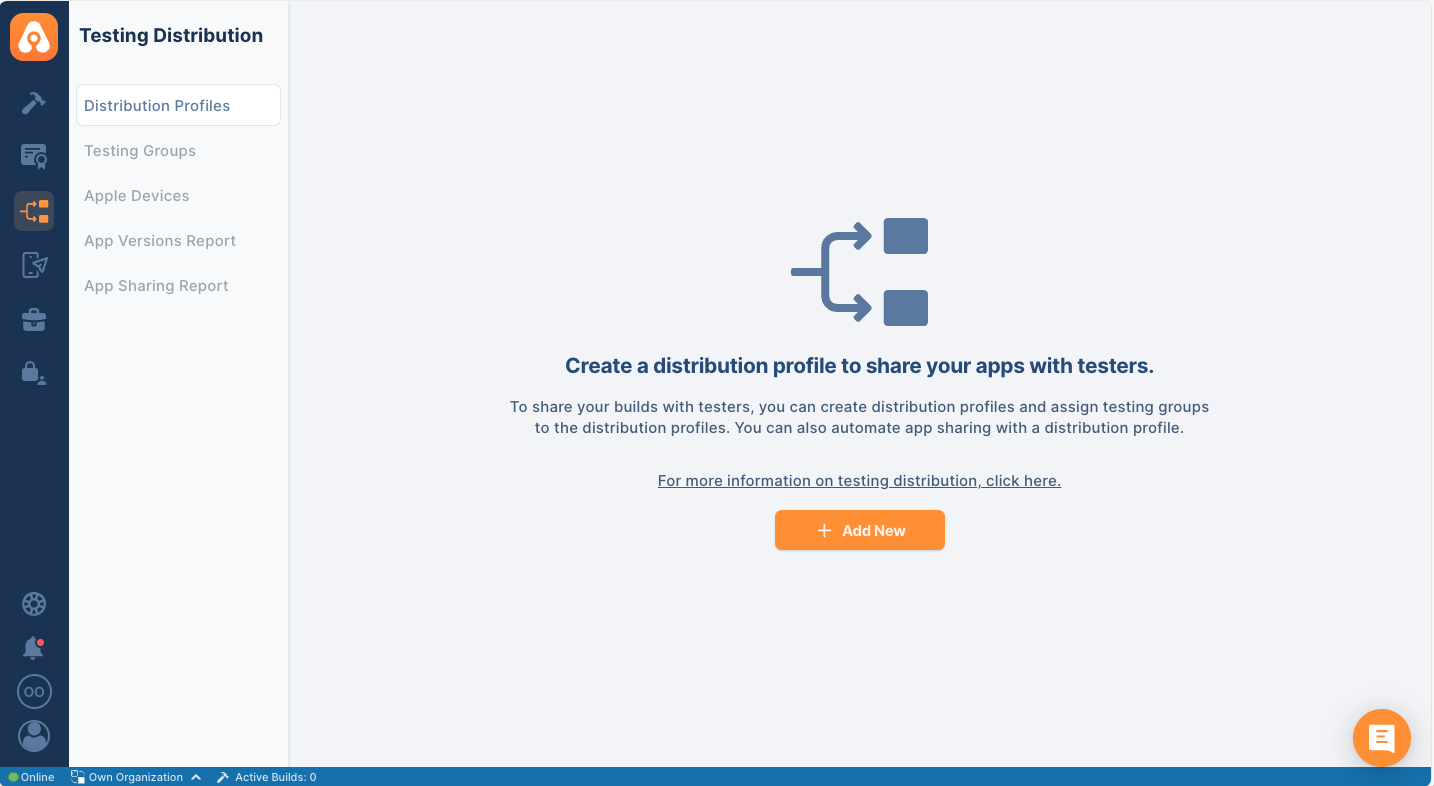
Note that an empty Testing Distribution profile named Send to Myself will be created automatically for you.
A distribution profile corresponds to the multiple versions of the same application for iOS and Android. You do not need to create multiple Testing Distribution profiles for iOS and Android applications of the same application.
Appcircle's Testing Distribution module allows you to distribute your application without the need for any external tools. However, the way your app is signed remains your responsibility and depends on your own workflows; therefore, if you are not enrolled in the Apple Enterprise Program, Appcircle will not provide an enterprise signing service.
Creating a Profile
Select the Testing Distribution from the left and click on the Add New button. Give a name to your distribution profile.
As a best practice, we recommend using one single distribution profile for both iOS and Android versions of the same application.
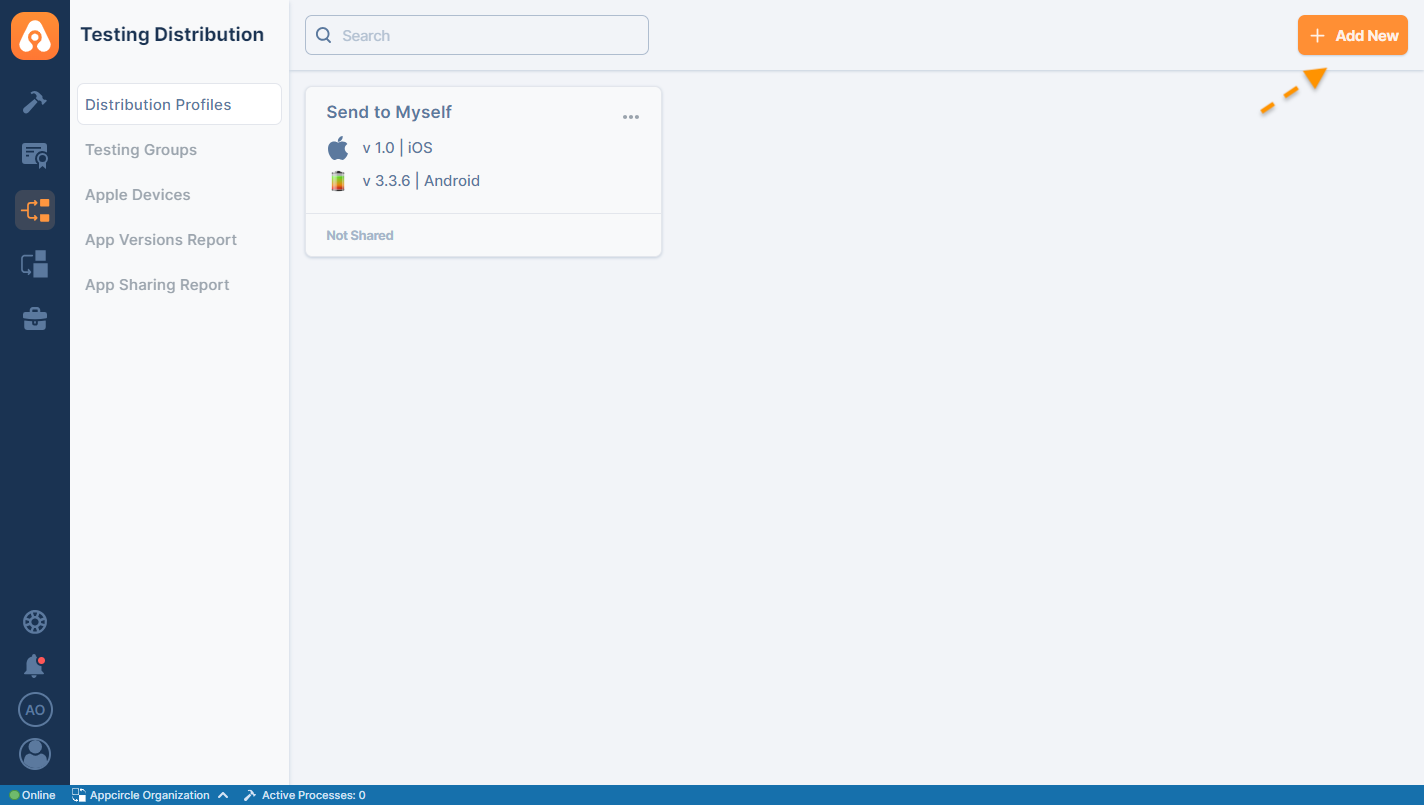
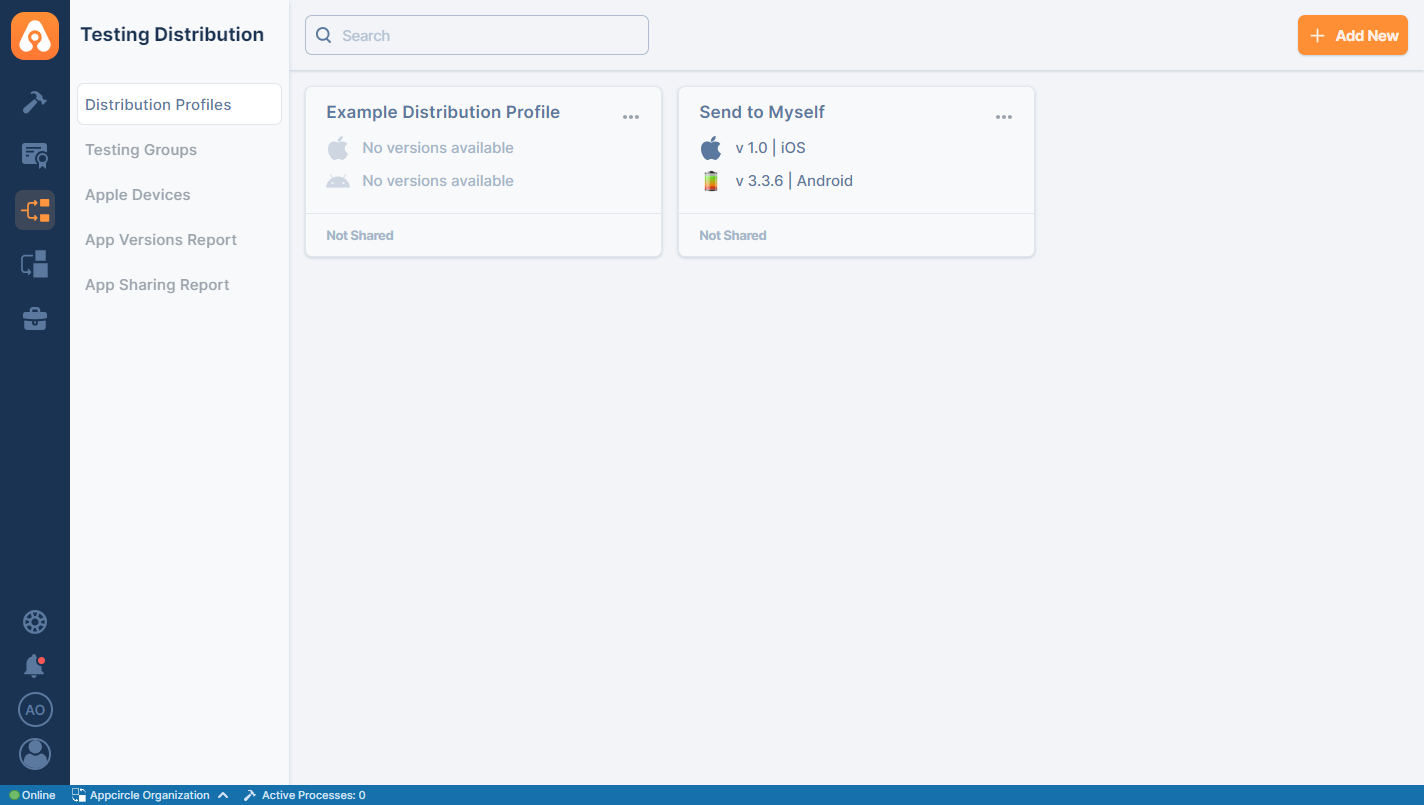
Profile Actions
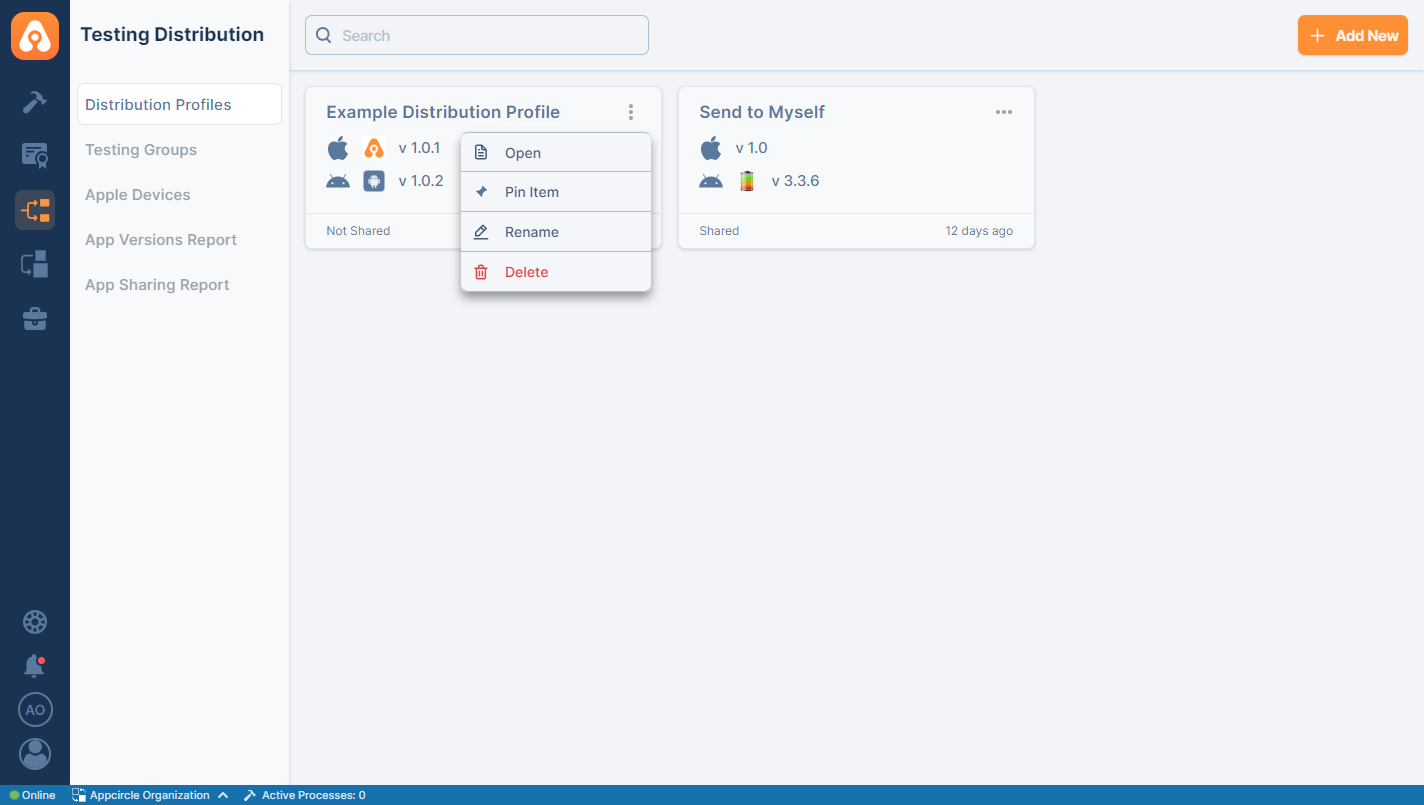
Rename a Distribution Profile
The Distribution Profile can be renamed by following these steps:
- Click on the three dot on the top right of the profile menu.
- Click
Rename. - Enter the new name for your profile.
Pin a Distribution Profile
The Distribution Profile can be pinned by following these steps:
- Click on the three dot on the top right of the profile menu.
- Click
Pin Item.
Pinned profiles will stand out by appearing first in the list, making them easily accessible and distinguishable from the rest of the profiles. A pin icon will also be displayed on their profile card.
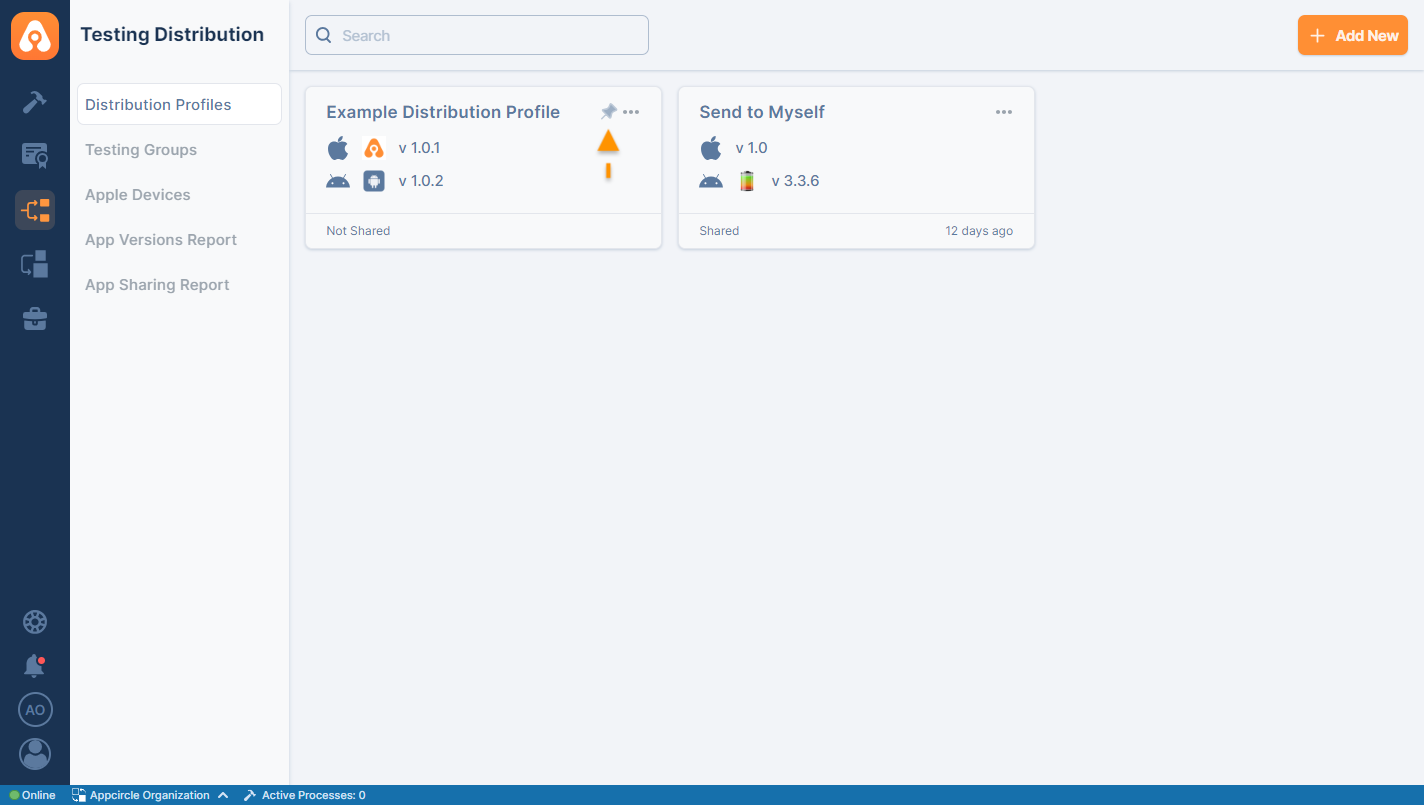
Delete a Distribution Profile
To remove clutter and/or free up storage, an entire profile can be deleted with a single click:
- Click on the three dot on the top right of the profile menu.
- Click
Delete. - Go through the confirmation dialog.
To free up space, other references pointing to the artifact should also be removed. For example, if the same artifact is present in the builds, those artifacts should also be deleted.
Uploading Binary
Manual Binary Upload
Pre-built iOS or Android applications can be uploaded for distribution or preview by using the upload field on the right panel (if no version is available) or the "Upload" button at the top right (if versions are already present) to upload files to the distribution profile.
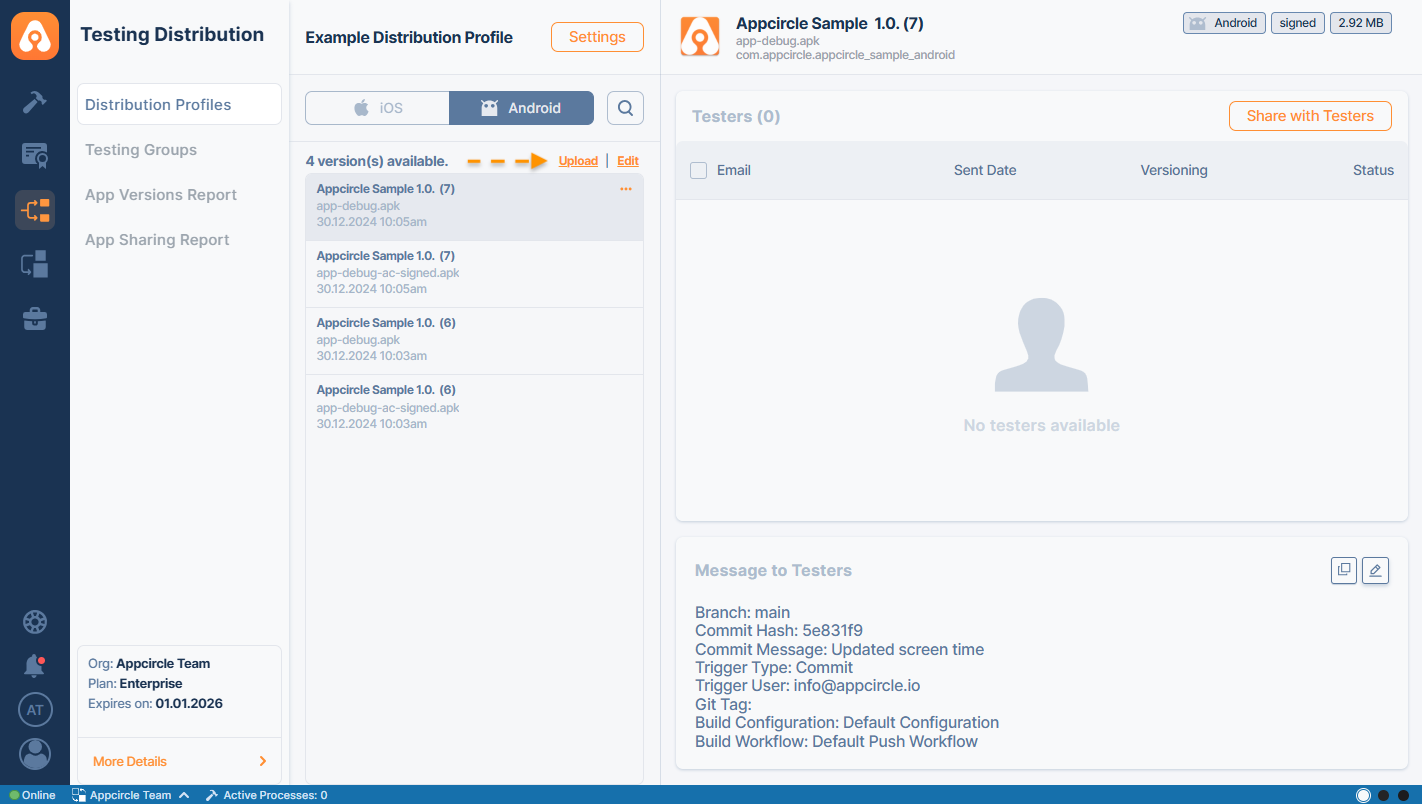
After the file is uploaded, it is checked for errors and parsed for metadata. Any errors that occur will be displayed in the upload area.
Once the upload is complete, the new version will be added to the top of the list with parsed metadata. This version can then be shared with testers or previewed on a virtual device in the browser.
Please note that iOS and Android binaries are displayed in separate tabs. The required OS tab should be clicked to navigate between them.
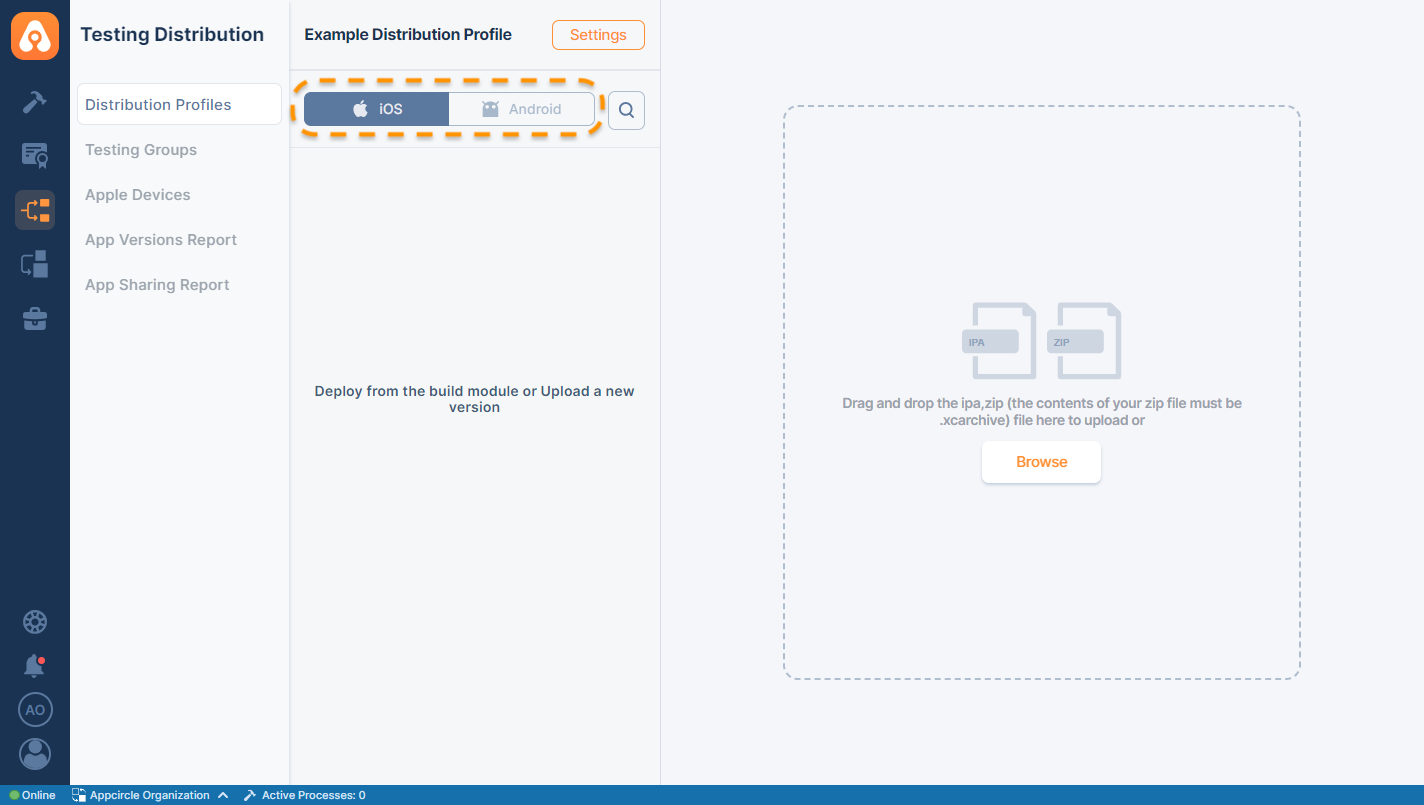
Upload via Build Module
With a successful build, a new version of the application will be added to the distribution profile.
Simply go to Build Module > Build Configuration > Distribution and select a distribution profile you want your build to be sent.
The Android build output can be selected as .AAB (Android App Bundle) from the configuration settings within the Build profile.
When the .AAB build is sent to the designated Testing Distribution profile, either automatically or manually by uploading the file directly within the Testing Distribution profile, it will be automatically converted to .APK format when shared with a Testing Group. This ensures that the .APK format is used for the artifact downloaded by the receiving tester.
This conversion capability also applies when app versions are sent from a Testing Distribution profile to an Enterprise App Store profile. The shared .AAB artifact will be converted and downloaded in .APK format from the Enterprise App Store profile.
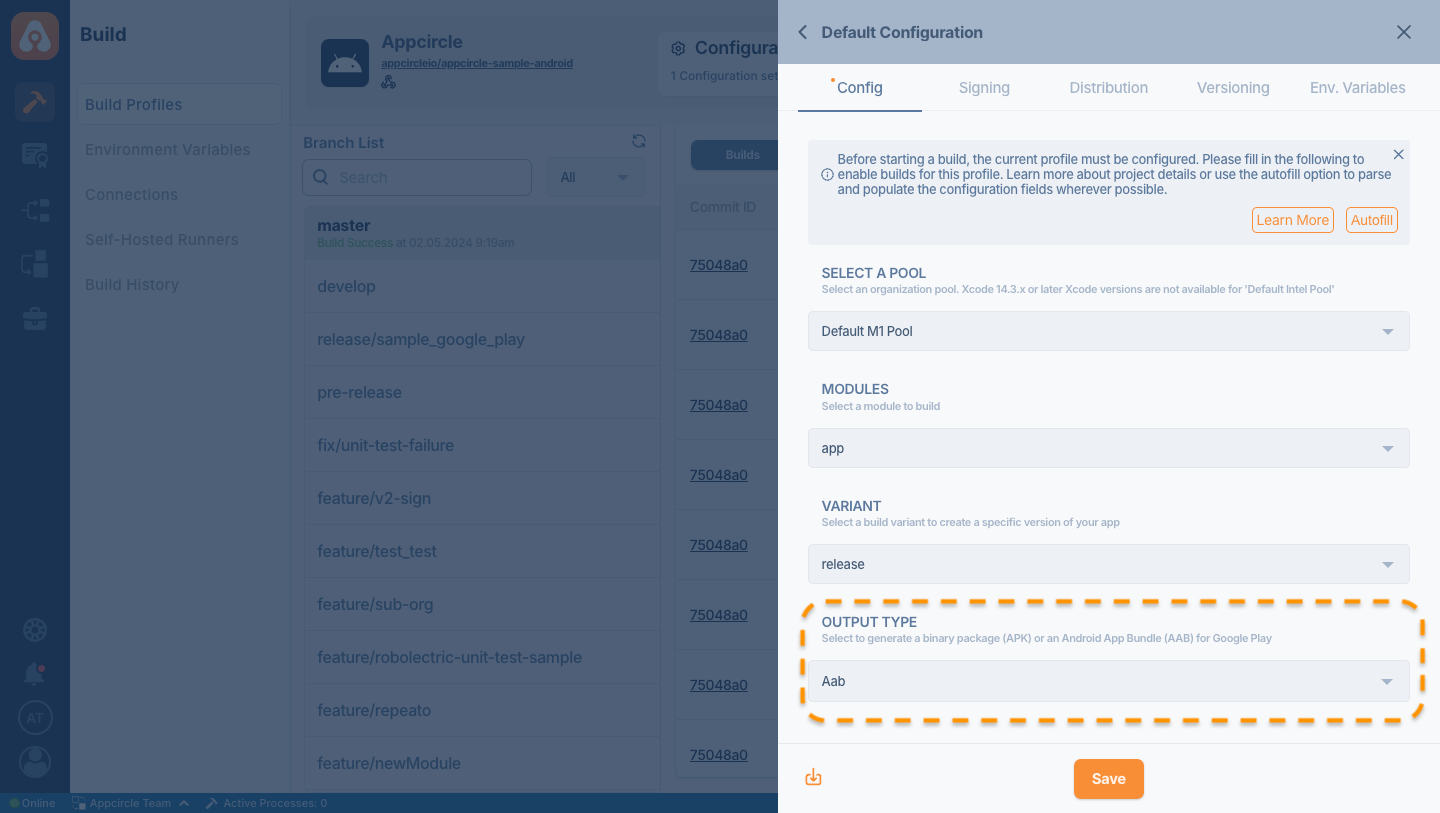
Only signed builds will be distributed. Unsigned builds will not be distributed.
Android applications with multiple flavors
For detailed information about multiple flavors, refer to this documentation:
Building Multiple Apps in One ProfileIf multiple product flavors are present in your Android application, a build will be created for each flavor, allowing for simultaneous distribution. A common use case for multi-flavor applications includes offering free and paid versions of the same application.
When an application with multiple flavors is built and distributed, an .apk file will be created for each flavor. Once distributed, all of the binaries will be visible on the distribution profile
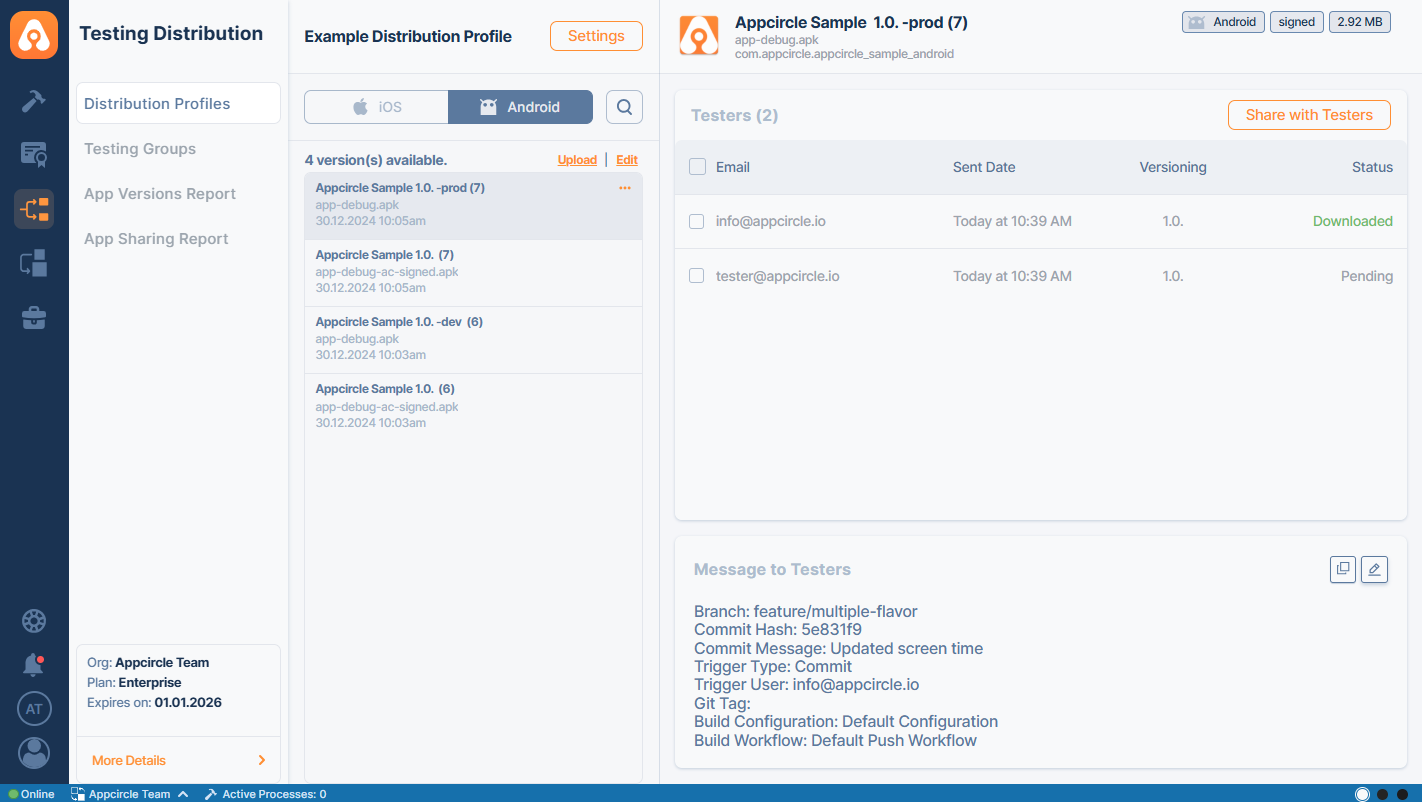
How to see the multiple flavor results
If you also want to download or see the output, you can check through the following steps within the Build Profile:
- Click the three dot under the actions tab
- Click Download Artifacts to see all the build outputs.
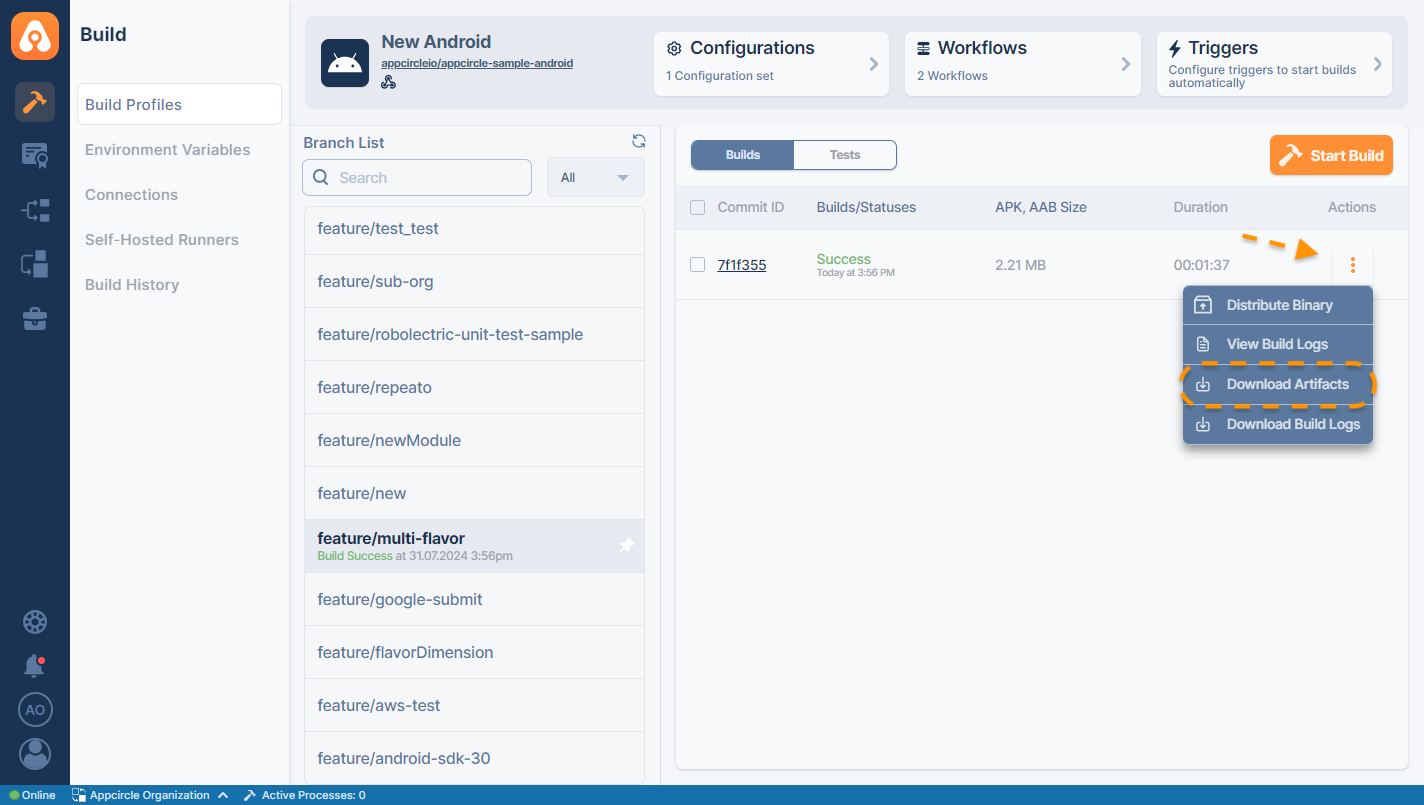
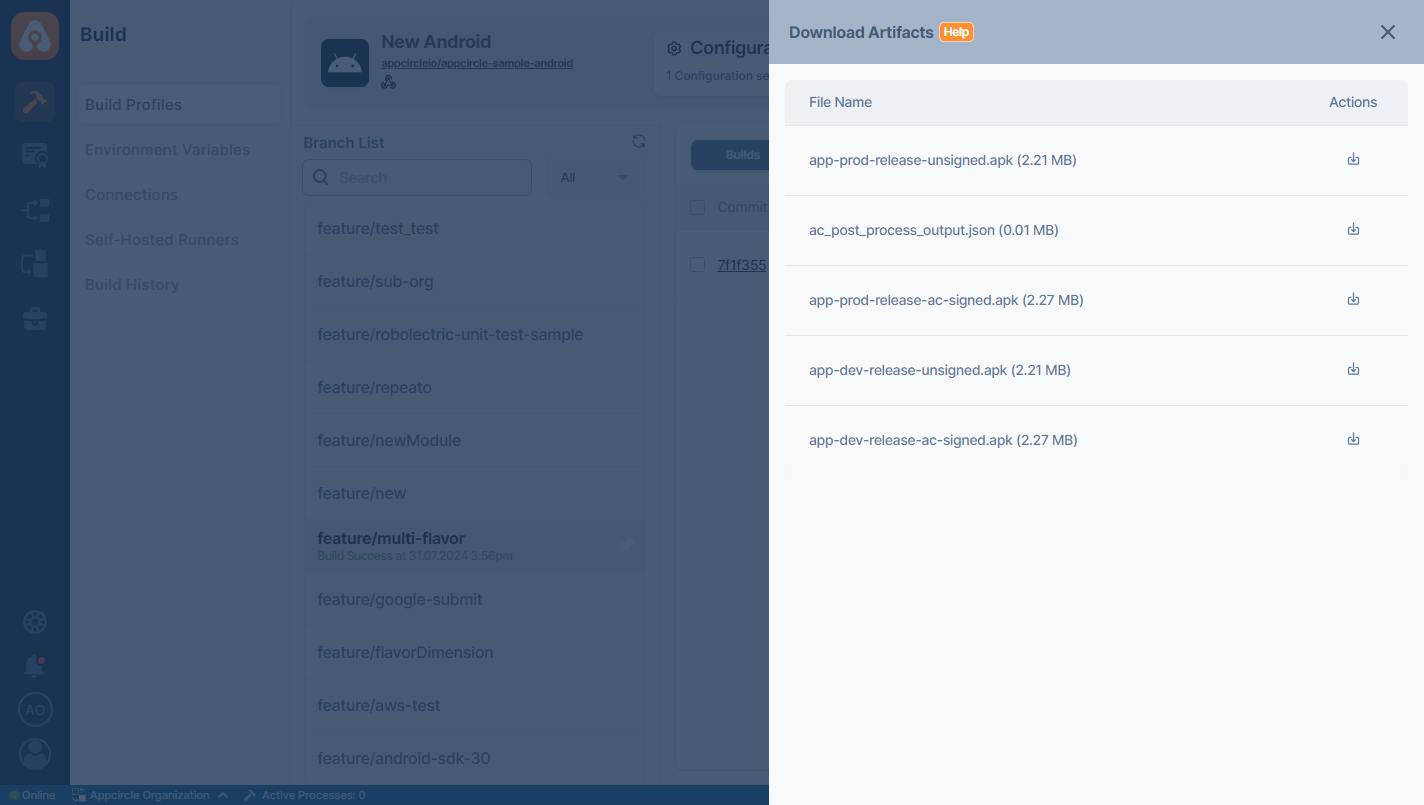
If your Git commit has any messages, they will be included in the distribution in Message To Testers area.
Upload using API & CLI
If you use your own CI structre, you can use our Appcircle API & CLI to upload binaries to your Distribution Profile.
To get more information, please refer to our API & CLI documentation.
Settings
The settings of your distribution profile can be customized. Click on the distribution profile, then click the settings button within the profile.
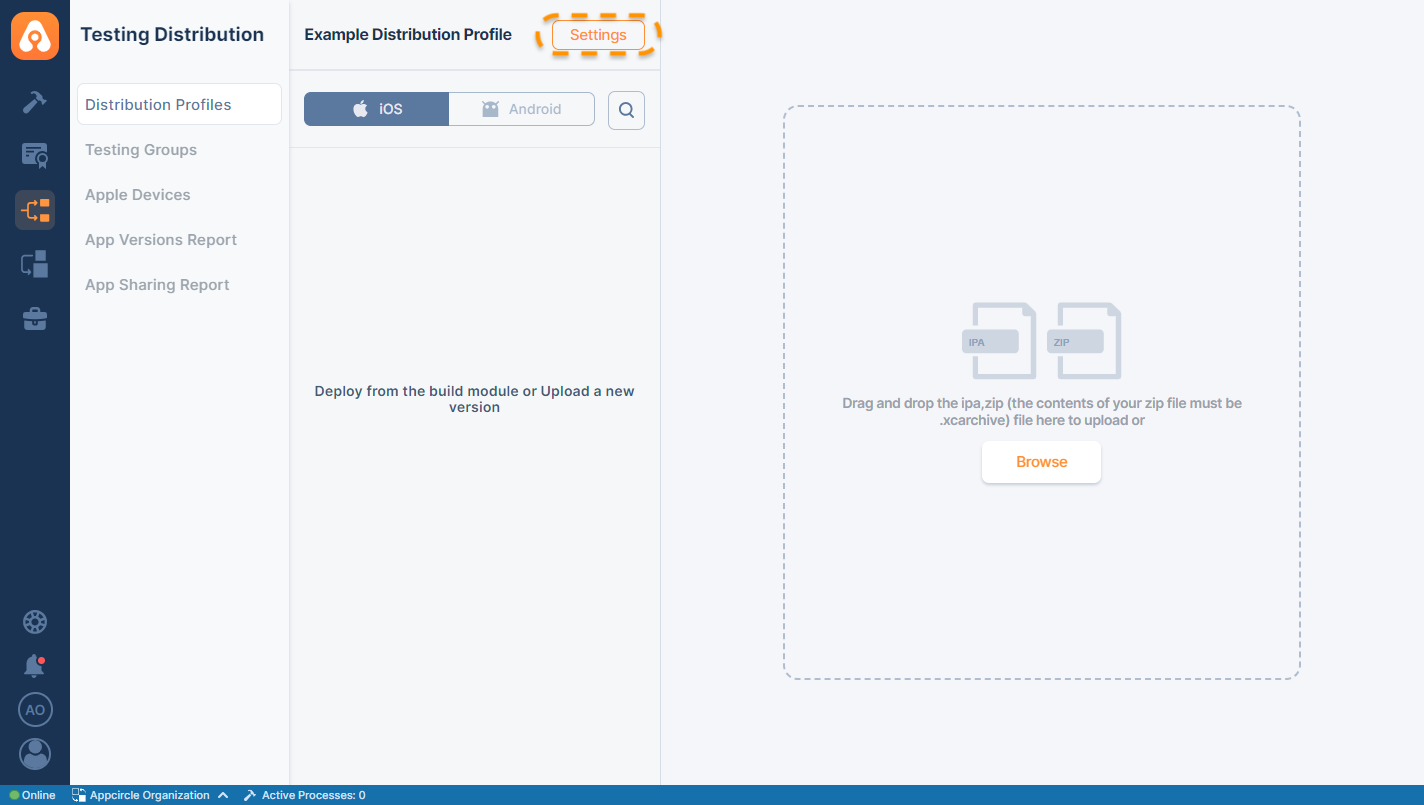
Information
The Info tab allows you to enter the publisher information for your distributed applications.
You can submit your Publisher Name, Contact Email, Privacy Policy URL, and Terms of Service URL.
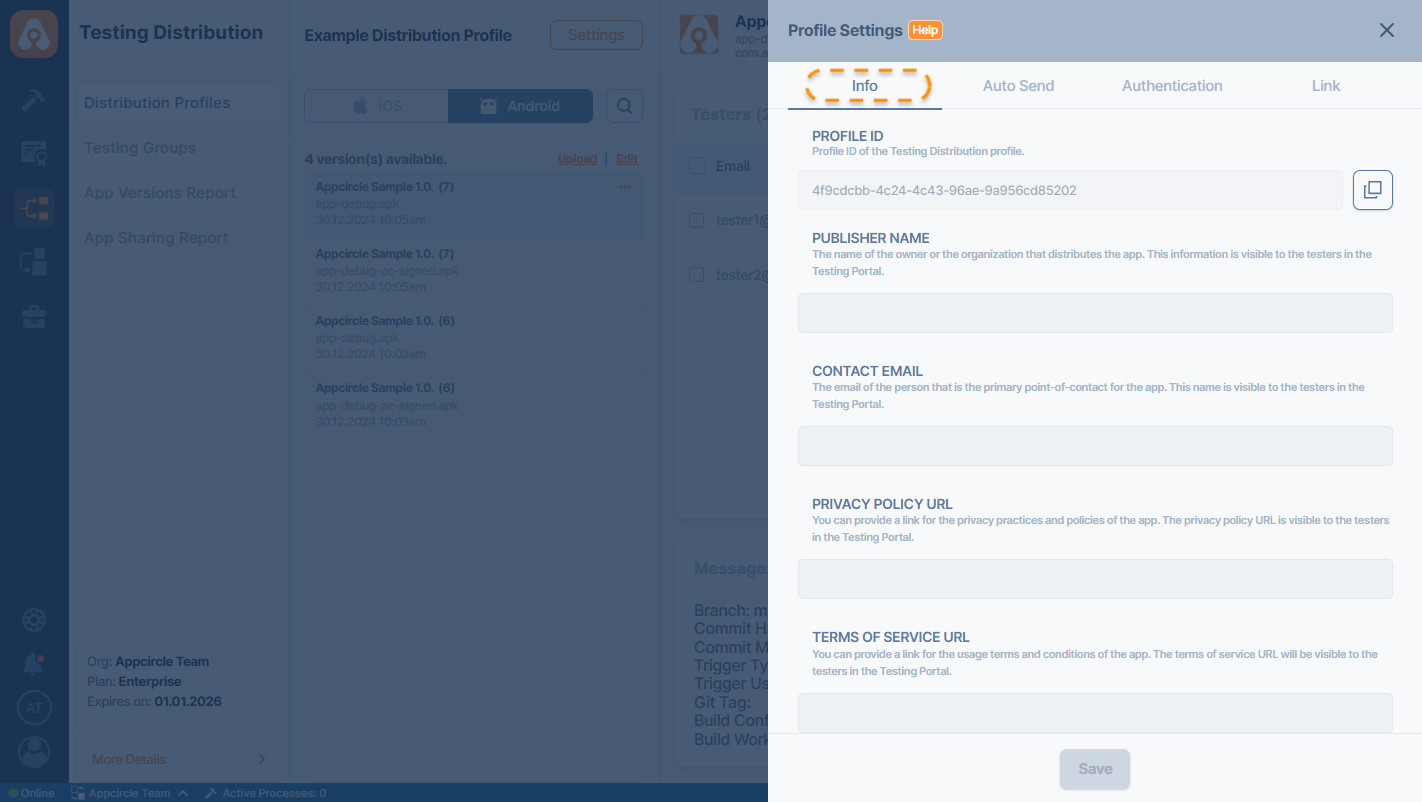
Once you click the save button, the information you have provided will be displayed on the Tester Portal.
Tester PortalWhen the tester selects the user icon, the Publisher Information will be displayed.
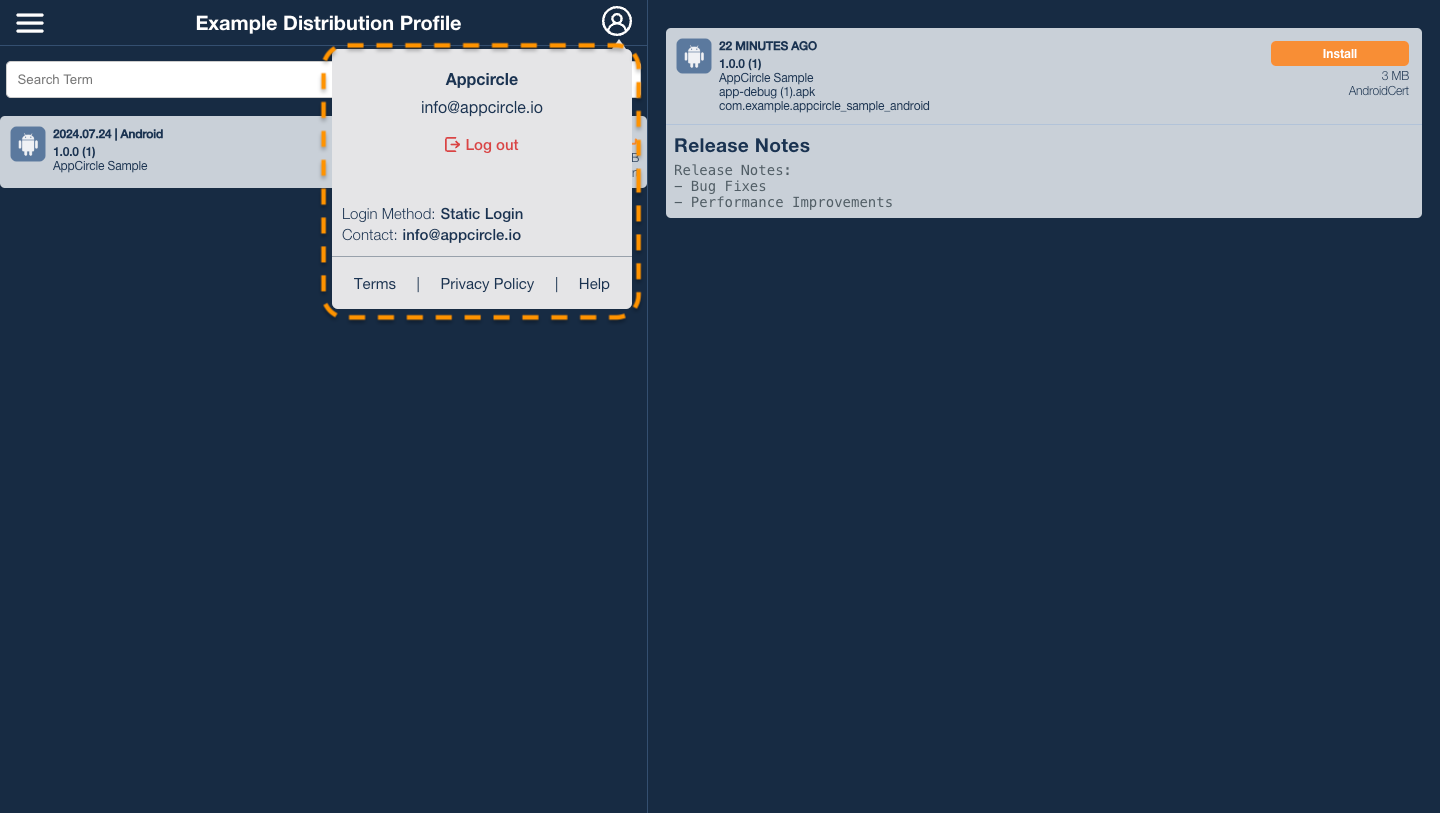
It will also display the Login Method for the Testing Distribution Profile.
In the example image, the profile has static authentication method, so it is displayed as Static Login.
You can find out more about the login methods in the using authentication for distribution section.
Hide From Profile List
The Hide from Profile List toggle allows you to exclude a Testing Distribution Profile and its associated binaries from appearing in the shared profile list on the Testing Portal. This is useful for limiting visibility of internal or early-stage builds while still enabling targeted distribution.
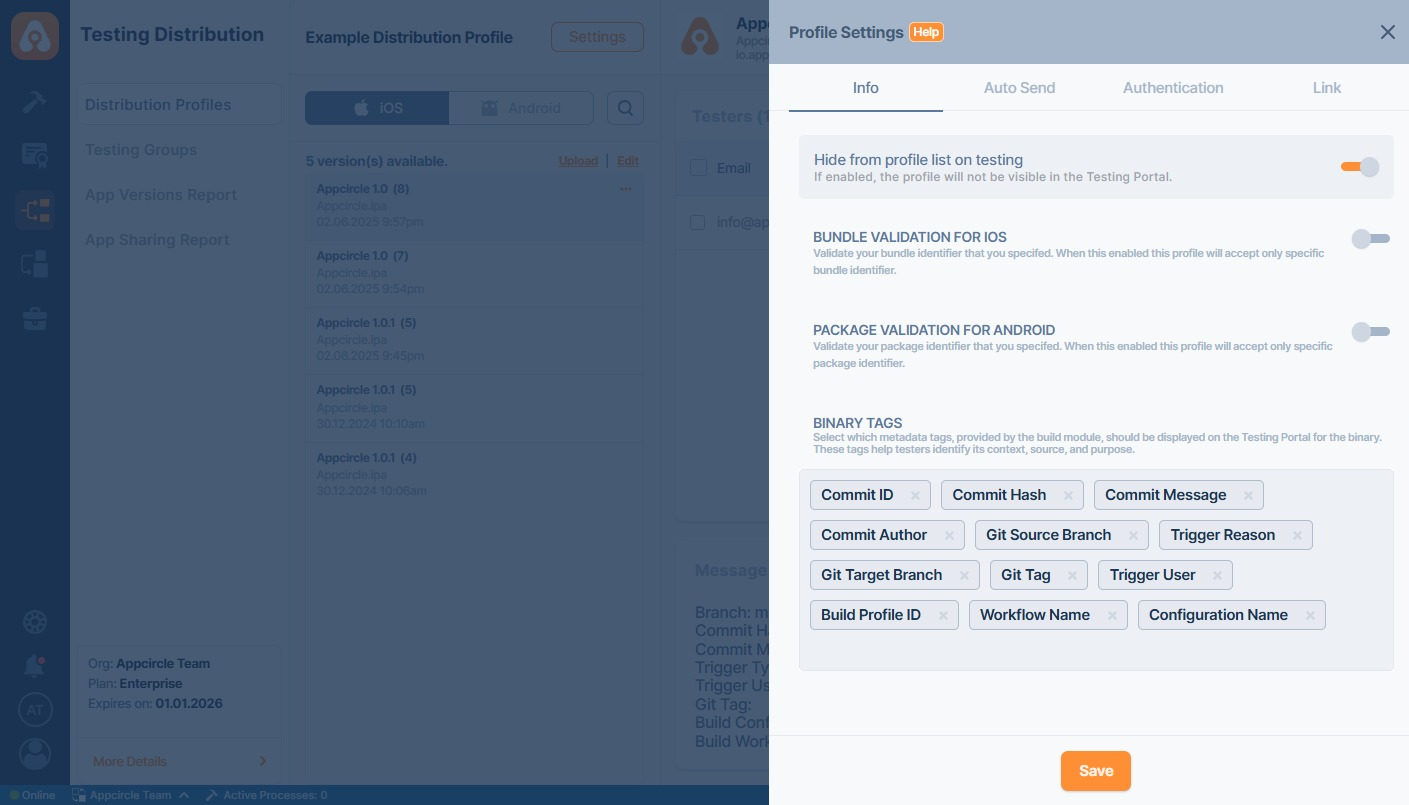
- When enabled, the profile will not be displayed in the shared list visible to testers browsing the portal.
- However, testers who received a direct email invitation to the profile will still be able to access and download the binary.
Bundle/Package Identifier Validation
You can enforce identifier validation to ensure consistency and prevent mismatches between uploaded binaries and profile settings:
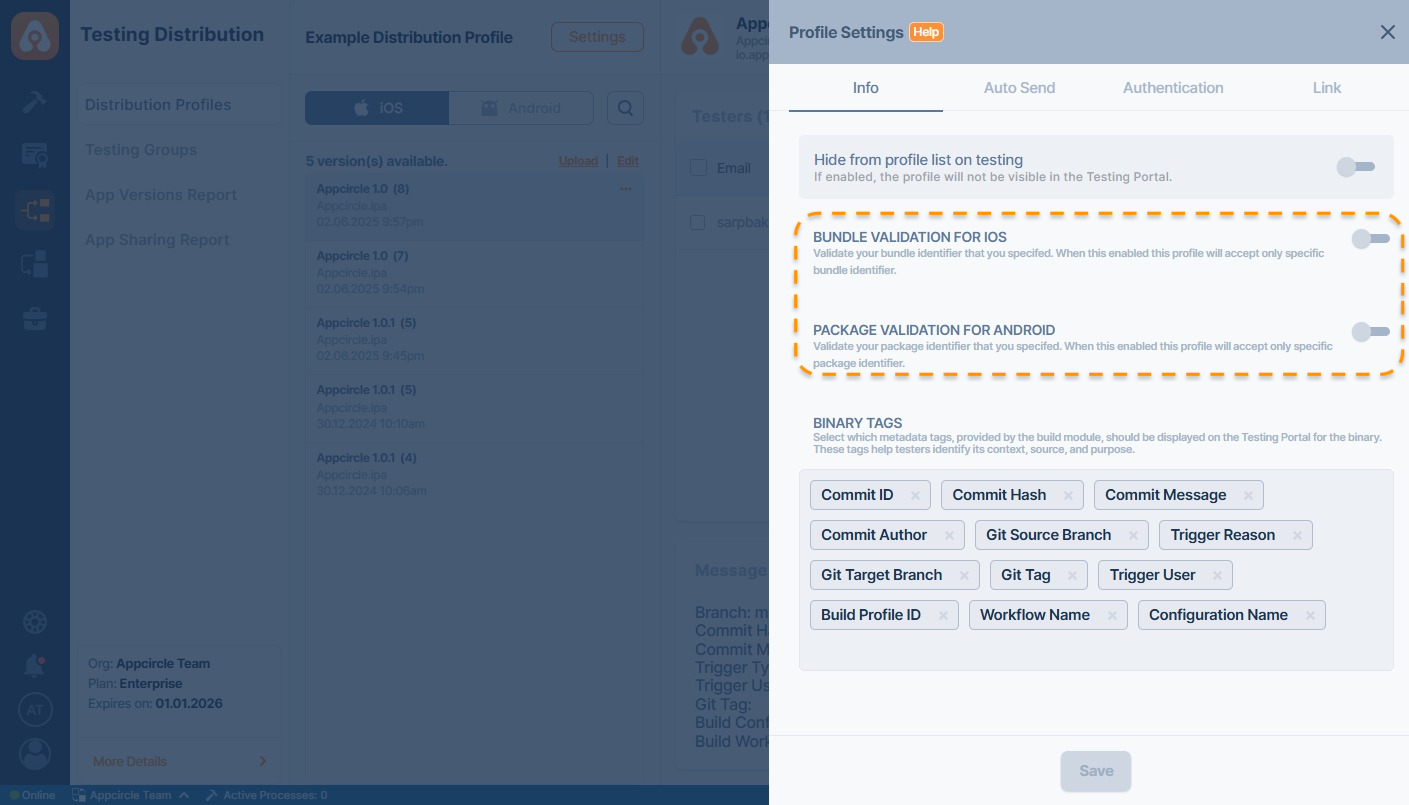
-
Bundle Validation for iOS: When enabled, this option restricts uploads to only those iOS binaries that exactly match the bundle identifier specified in the profile. This ensures that only binaries from the intended iOS application are accepted.
-
Package Validation for Android: When enabled, this option restricts uploads to only those Android binaries that exactly match the package identifier specified in the profile. This ensures that only binaries from the intended Android application are accepted.
When you want to send a binary to a Testing Distribution profile with Bundle/Package validation via Build module, Appcircle allows this profile to be selected in the build configuration, but if the identifier of the binary from the build module does not match the one specified in the Testing Distribution profile, you will get an error.
For more detailed information about automatic distribution, please visit the Distribution Configuration documentation.
When either validation is active, binaries with mismatching identifiers will be rejected during upload.
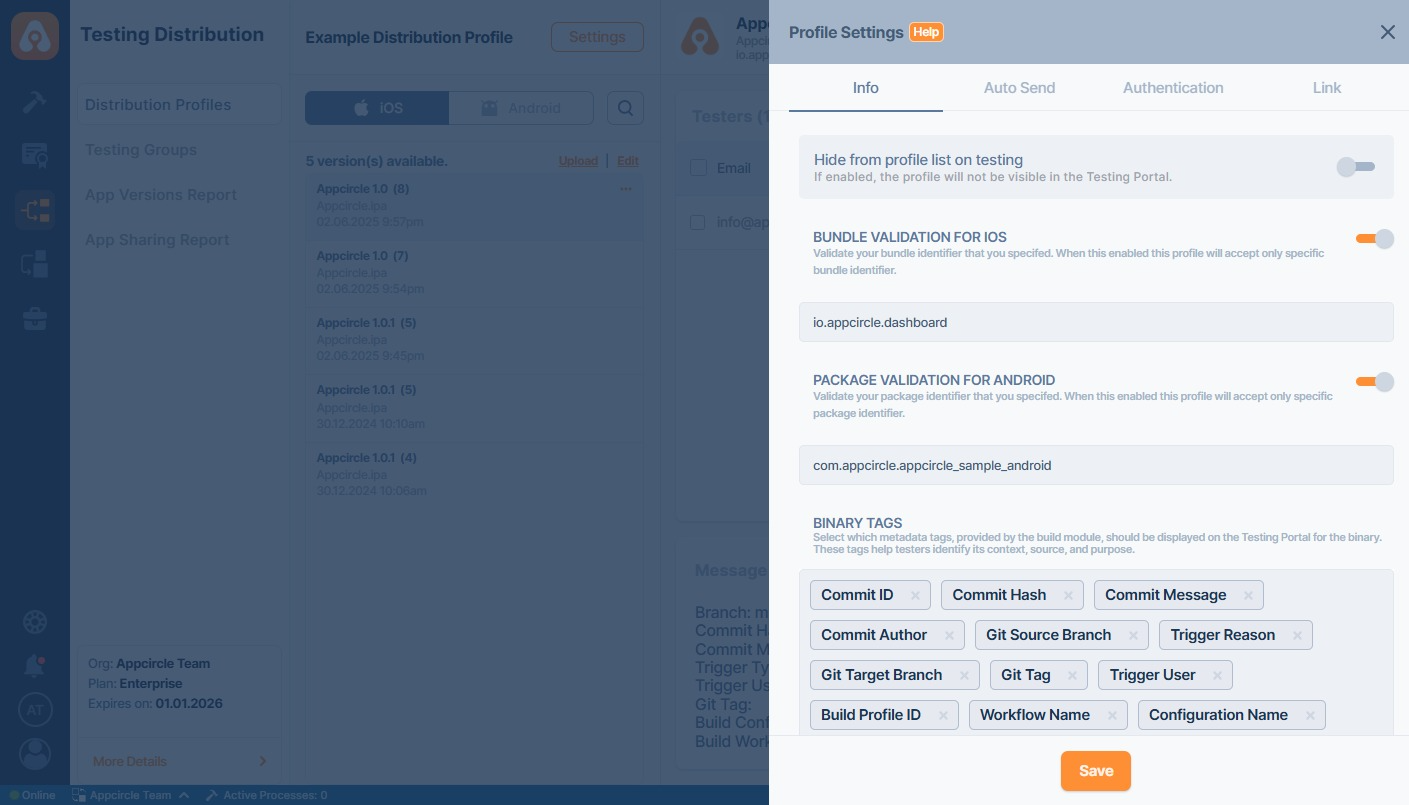
When Bundle/Package Identifier Validation is enabled, the profile header will display a Locked tag next to the configured bundle or package identifier. This indicates that the profile is now restricted and will only accept binaries that match the identifier defined in the profile settings.
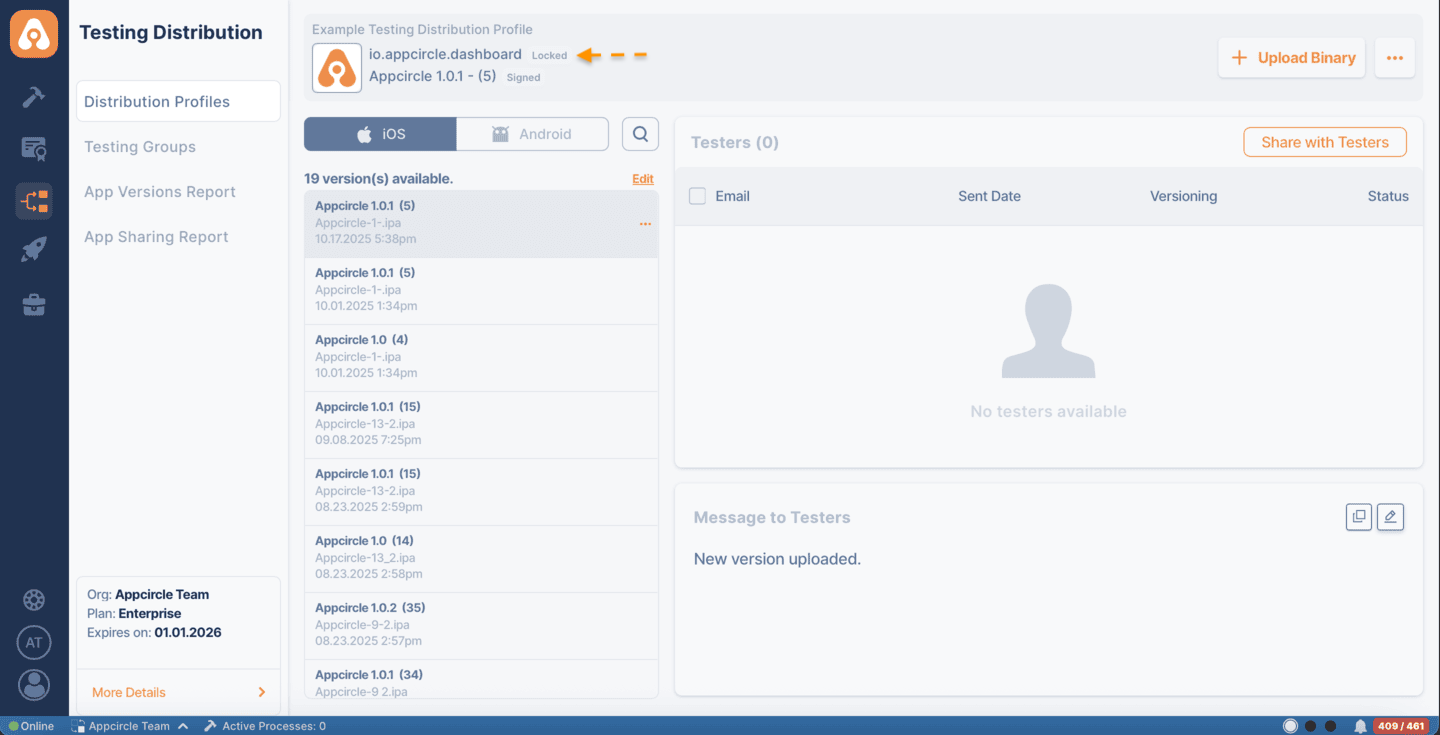
This validation does not apply retroactively to existing binaries already uploaded to the profile. Previously uploaded binaries with a different bundle or package identifier will remain accessible and can still be shared with testers. However, all new uploads must match the locked identifier, otherwise they will be rejected during upload.
Binary Tags
The Binary Tags feature allows you to label your application binaries with meaningful metadata, which is displayed on the Testing Portal for easy identification by testers.
These tags help testers understand each binary's origin, purpose, and how it was triggered. The available tags are:
- Commit ID
- Commit Hash
- Commit Message
- Commit Author
- Git Source Branch
- Trigger Reason
- Git Target Branch
- Git Tag
- Trigger User
- Build Profile ID
- Workflow Name
- Configuration Name
This section appears only if the binary is distributed to the Testing Distribution profile from the Build Module.
Uploaded binaries without metadata from a build module won’t show the selected tags on the Testing Portal.
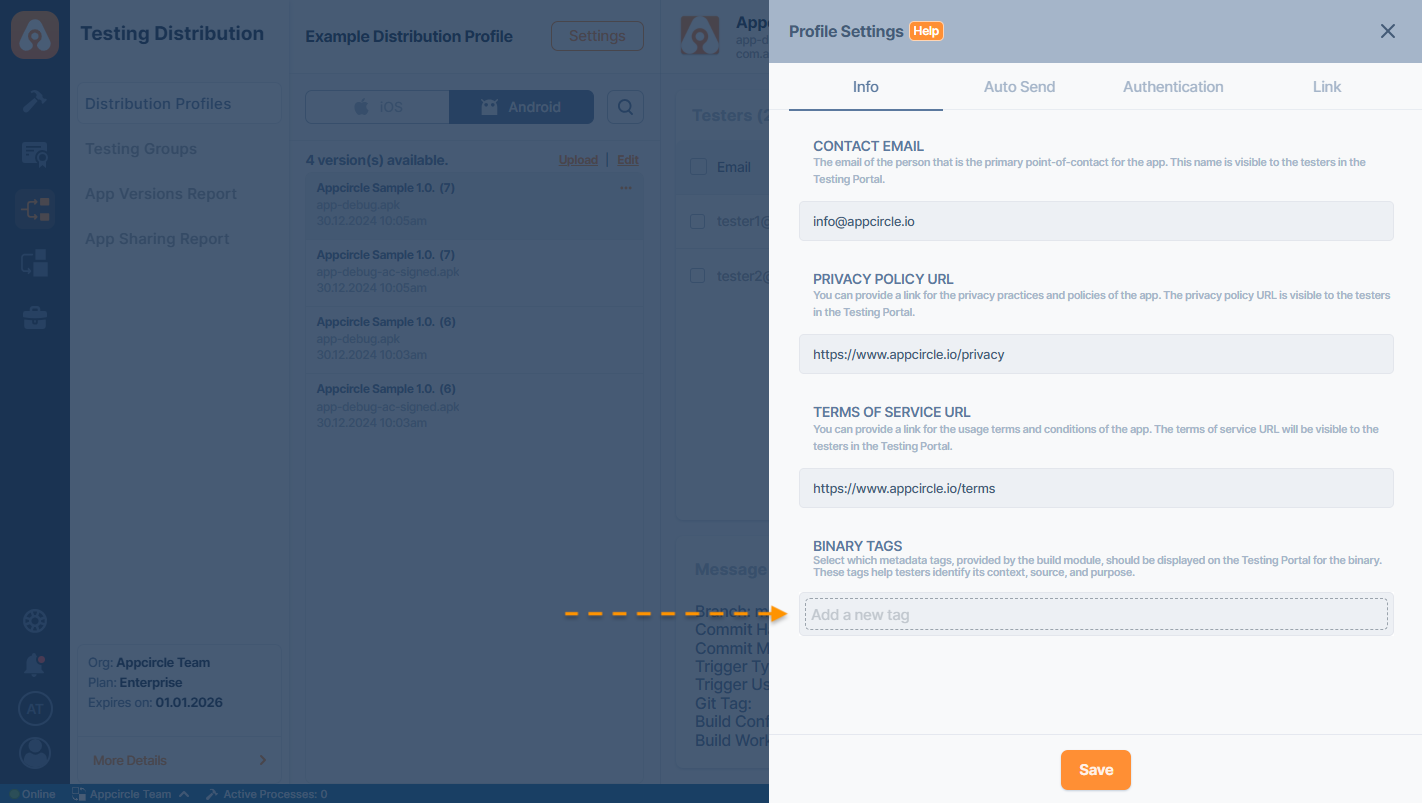
Binary tags can be managed through the Testing Distribution Profile Settings under the Info tab:
- Navigate to Testing Distribution module.
- Select the relevant distribution profile.
- Click the Settings icon.
- Under the Info tab, locate the Binary Tags section.
- Use the “Add a new tag” field to enter or select tags.
- Click Save to apply changes.
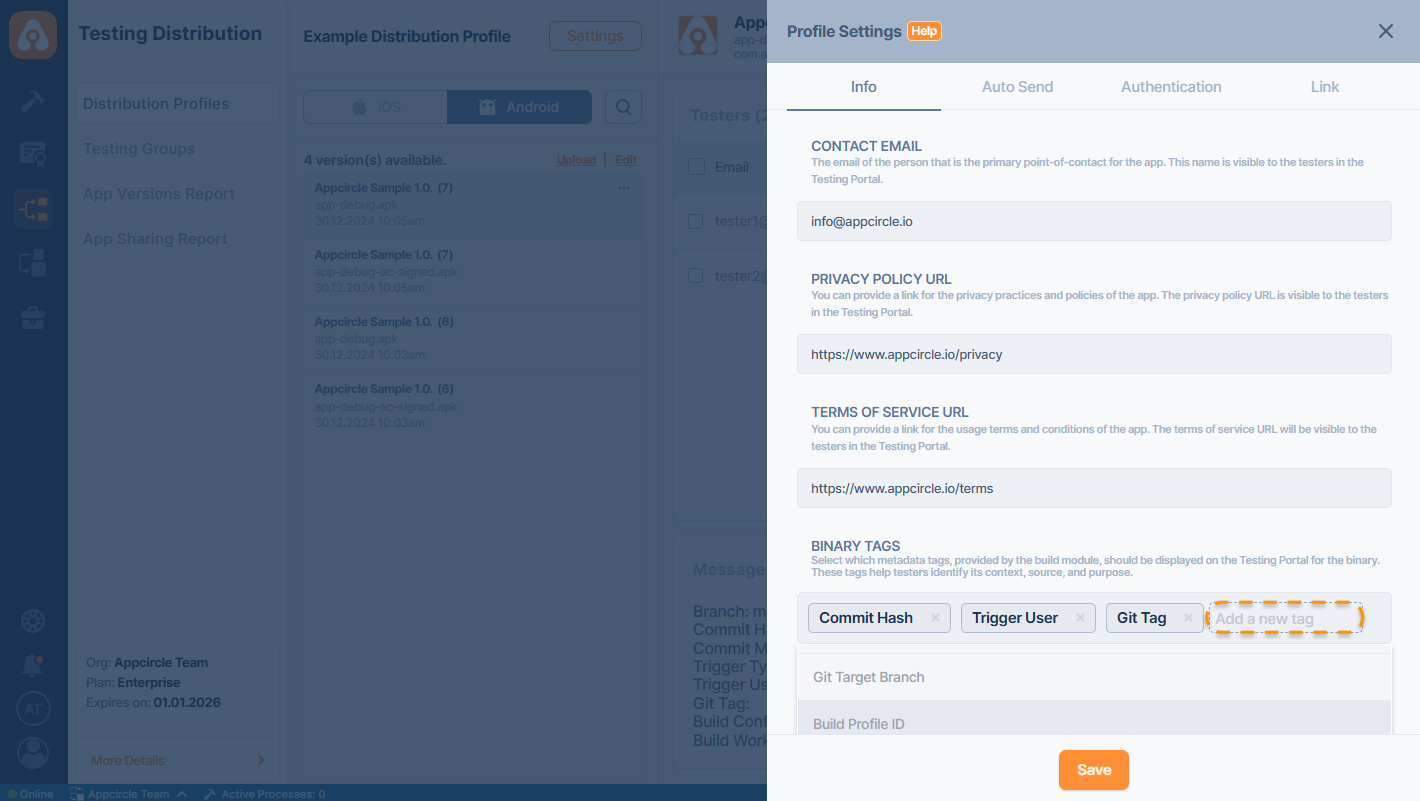
Once tags are saved in the profile settings:
- Tags will automatically appear next to the app version on the Testing Portal after being distributed.
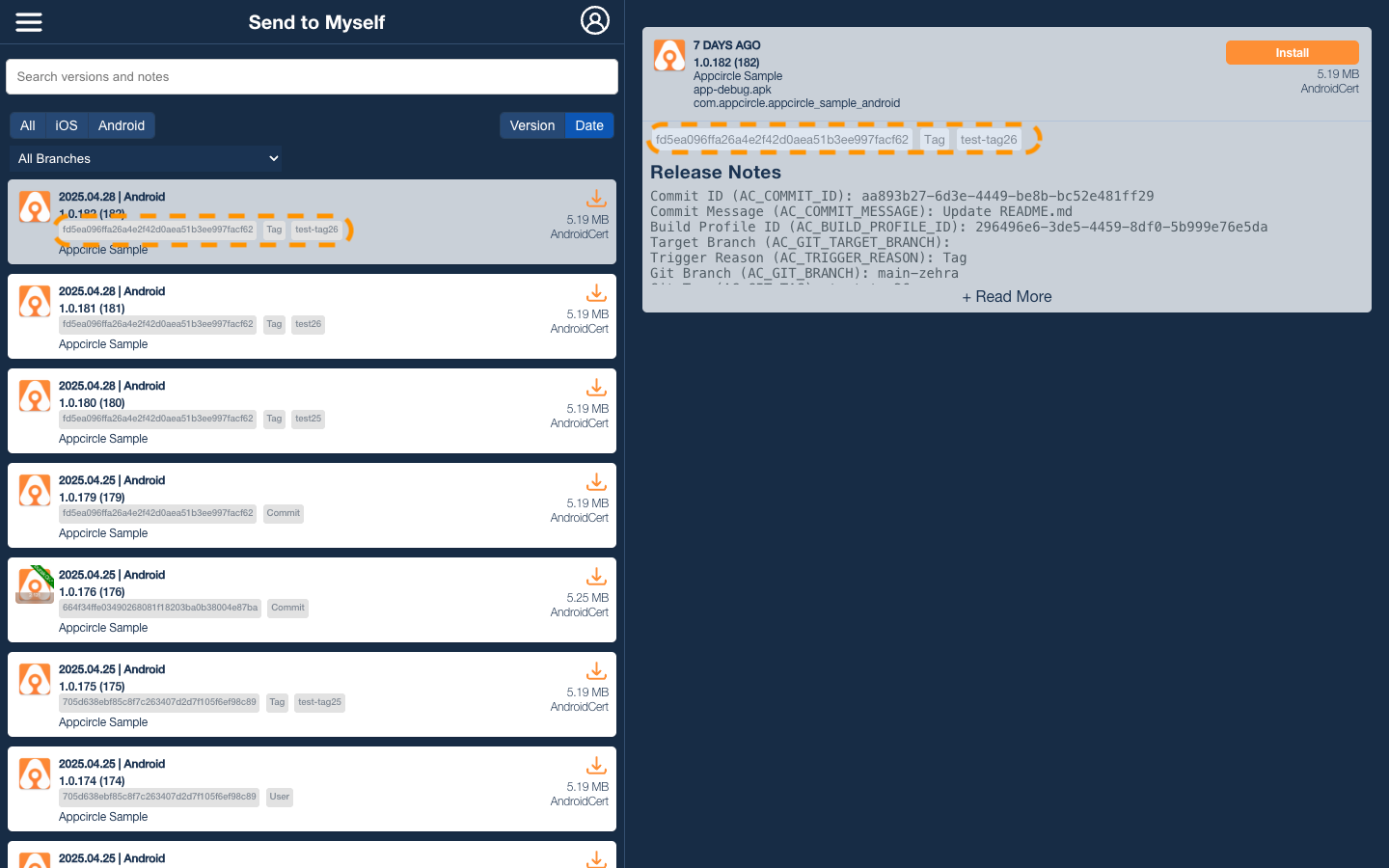
This visibility allows testers to filter and select the appropriate version for testing based on context.
Auto Send
Auto send feature lets your applications be distributed to specific testing groups whenever a new version is deployed, whether the deployment is triggered via a build process, CLI, or manual upload.
To enable the auto send feature, you need to create testing groups and add testers to these groups.
Testing GroupsUnder the Auto Send tab in the settings, you can see the testing groups you have created earlier. Just enable each testing group you want to have your application sent automatically whenever a new version is deployed.
The first section allows you to share the deployed binaries automatically with the selected groups. They will receive a link to download the specific version on their mobile devices.
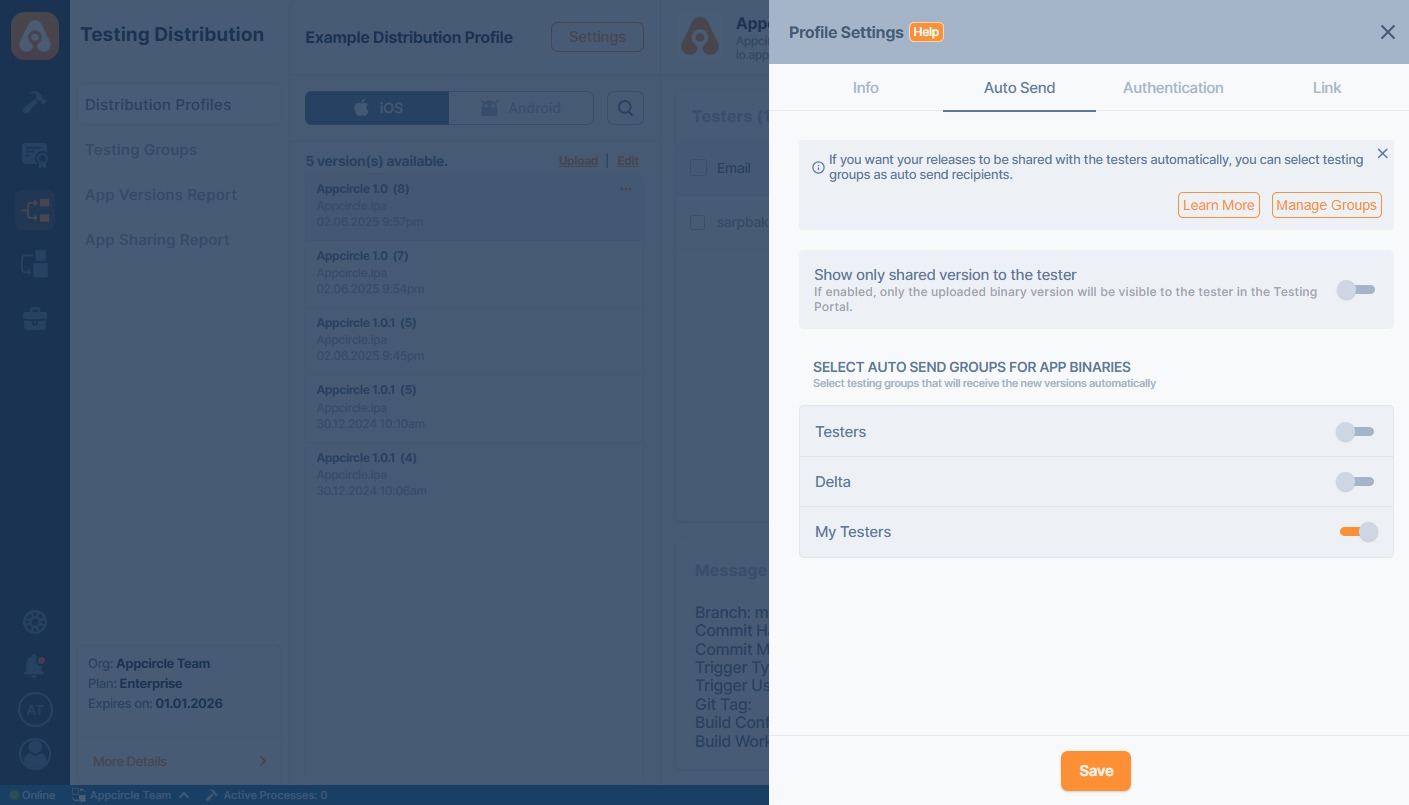
Your application will be sent to the related testing groups as soon as your build is complete, or when a package is manually uploaded or deployed via CLI.
Show Only the Shared Version to the Tester
When the “Show Only the Shared Version to Tester” toggle is enabled, receiving-end testers will only be able to access the most recently uploaded binary version within the Testing Portal, provided that the Auto-Send feature is enabled.
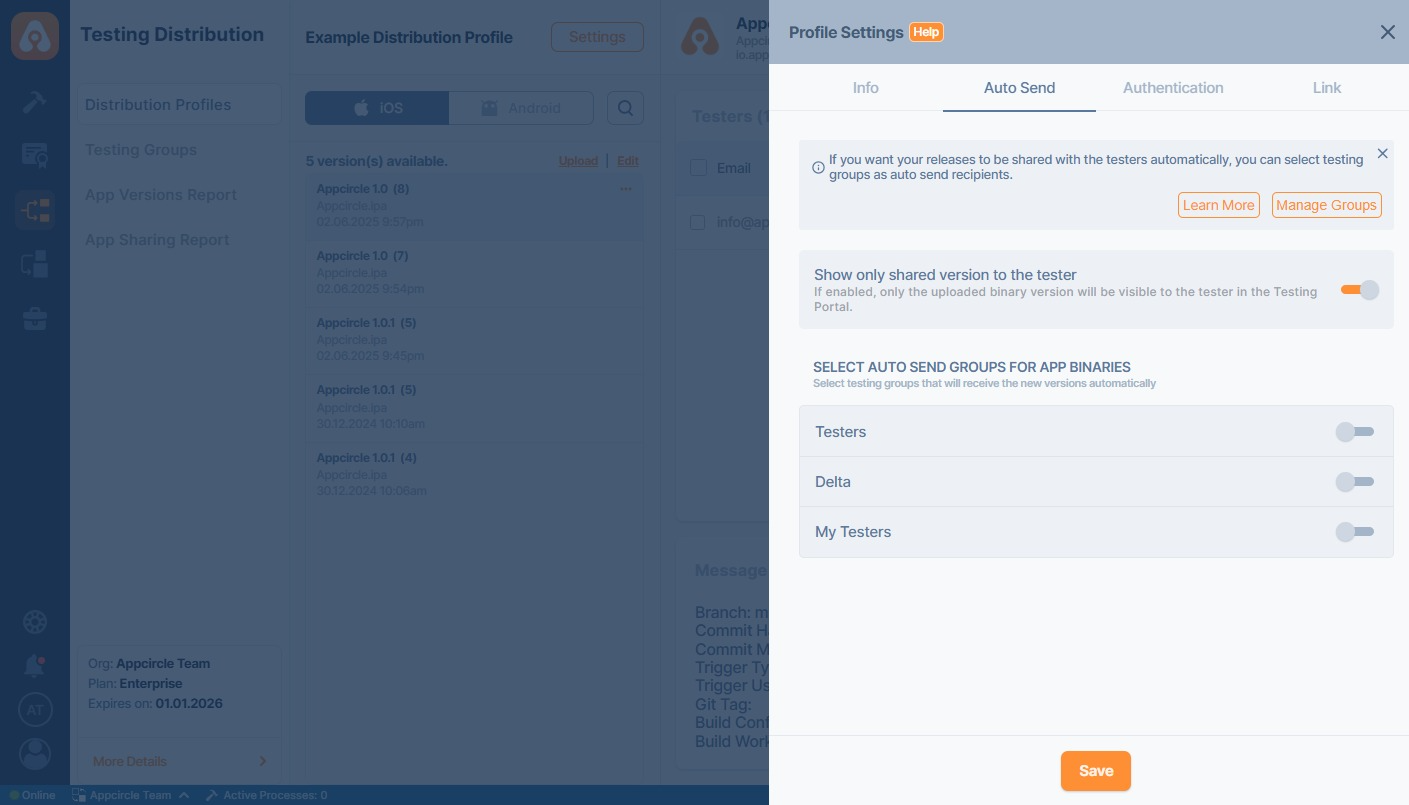
When this option is enabled, testers will not have access to the search bar or shared testing distribution profiles within the Testing Portal, as they will only receive the latest shared version.
Authentication
Under the Authentication tab in the settings, you can select a preferred authentication method for sharing your application. This will be the login method for the Testing Portal.
- None: No authentication, anyone with the link can download binary files
- Static Username and Password: One single username and password for all testers
- SSO Login: SSO login for all testers (Enterprise accounts only)
- LDAP Login: LDAP login for all testers (Enterprise accounts only)
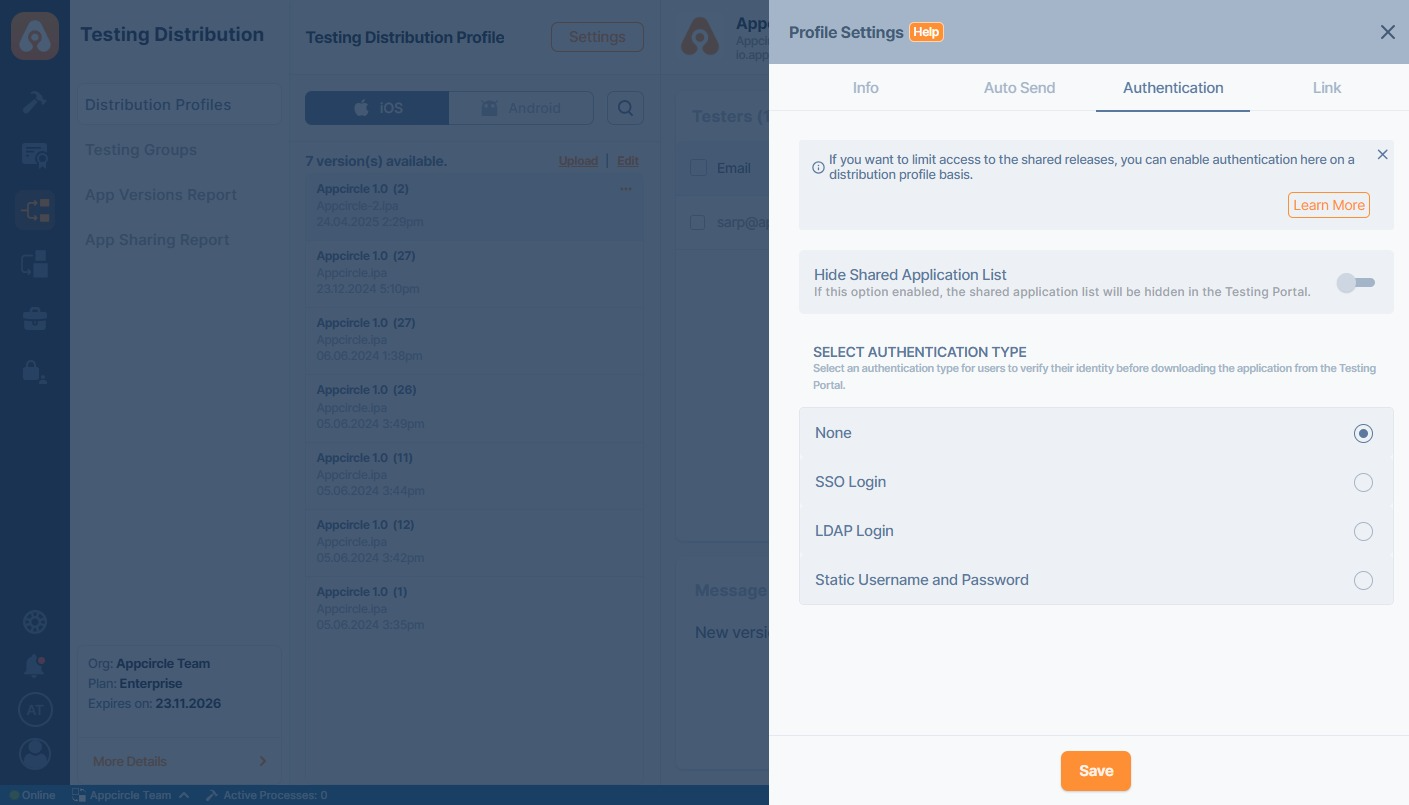
To add your SSO and LDAP details, go to My Organization Security screen and press the "Connect" button next to SSO Login or LDAP Login under the "Authentications" section.
SSO Login LDAP LoginIf SSO and LDAP details are not configured for your organization, these authentication methods will not be visible in the Distribution Profile settings.
Hide Shared Application List
You can restrict access to the shared application list within the Testing Portal by enabling the Hide Shared Application List toggle under the Authentication tab of a Testing Distribution Profile.
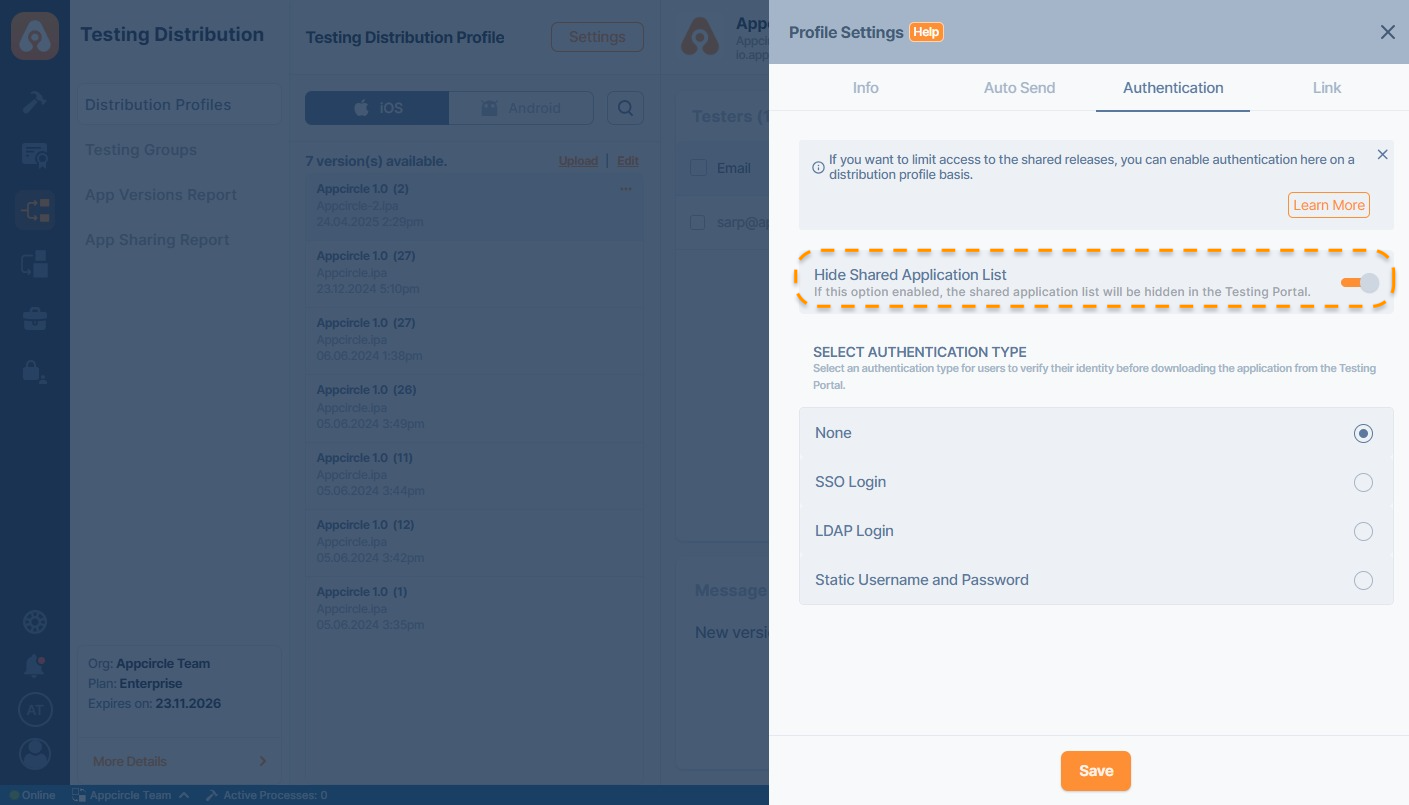
When enabled:
- The Shared Application List will be hidden for users accessing the Testing Portal.
- This restriction applies regardless of the selected authentication type (None, SSO Login, LDAP Login, or Static Username and Password).
- Testers will only see the application(s) associated with the specific distribution profile and will not be able to browse shared releases from other profiles.
Distribution Link
You may enable a link for your distribution. This allows anyone who has the link to access all artifacts of the distribution profile. Additionally, users can now conveniently scan a QR code to retrieve the distribution link directly. This simplifies the process of accessing and sharing the distribution link, making it more accessible for users on mobile devices or others who prefer quick scanning.
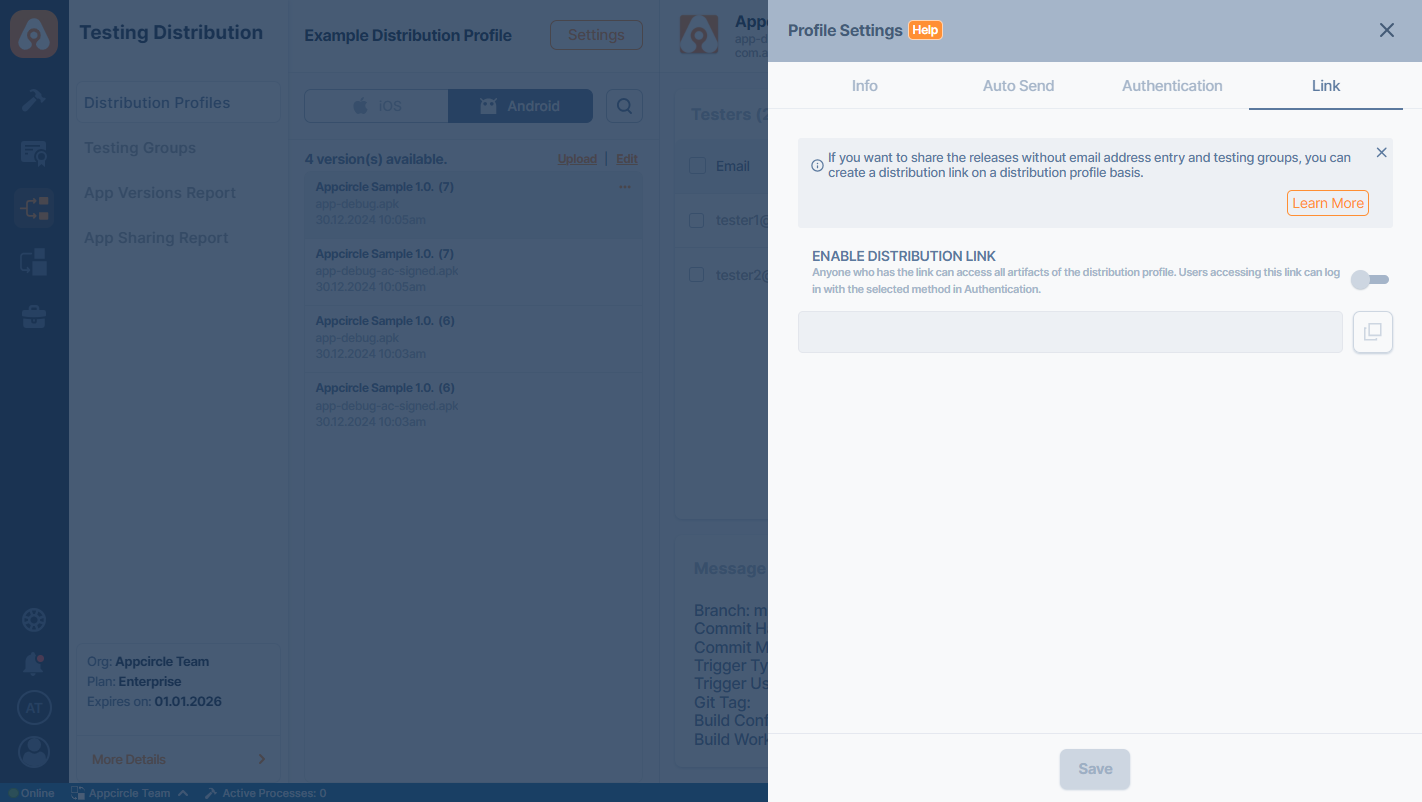
The Tester Portal that you will have access via the Distribution Link, will have the same authentication method that you have set from the authentication settings.
Share Binary
Share your application with the test groups manually
Once your build is ready or the binary file is uploaded to Appcircle, the file can be manually sent to testers for downloading, installing on their devices, and running the application for testing purposes.
Click on the 'Share with Testers' button, and the testing groups previously created can be selected to receive this version of your application. Alternatively, email addresses of testers can be entered here to send the application directly, bypassing the testing groups.
You can also add a message to testers including testing instructions and release notes.
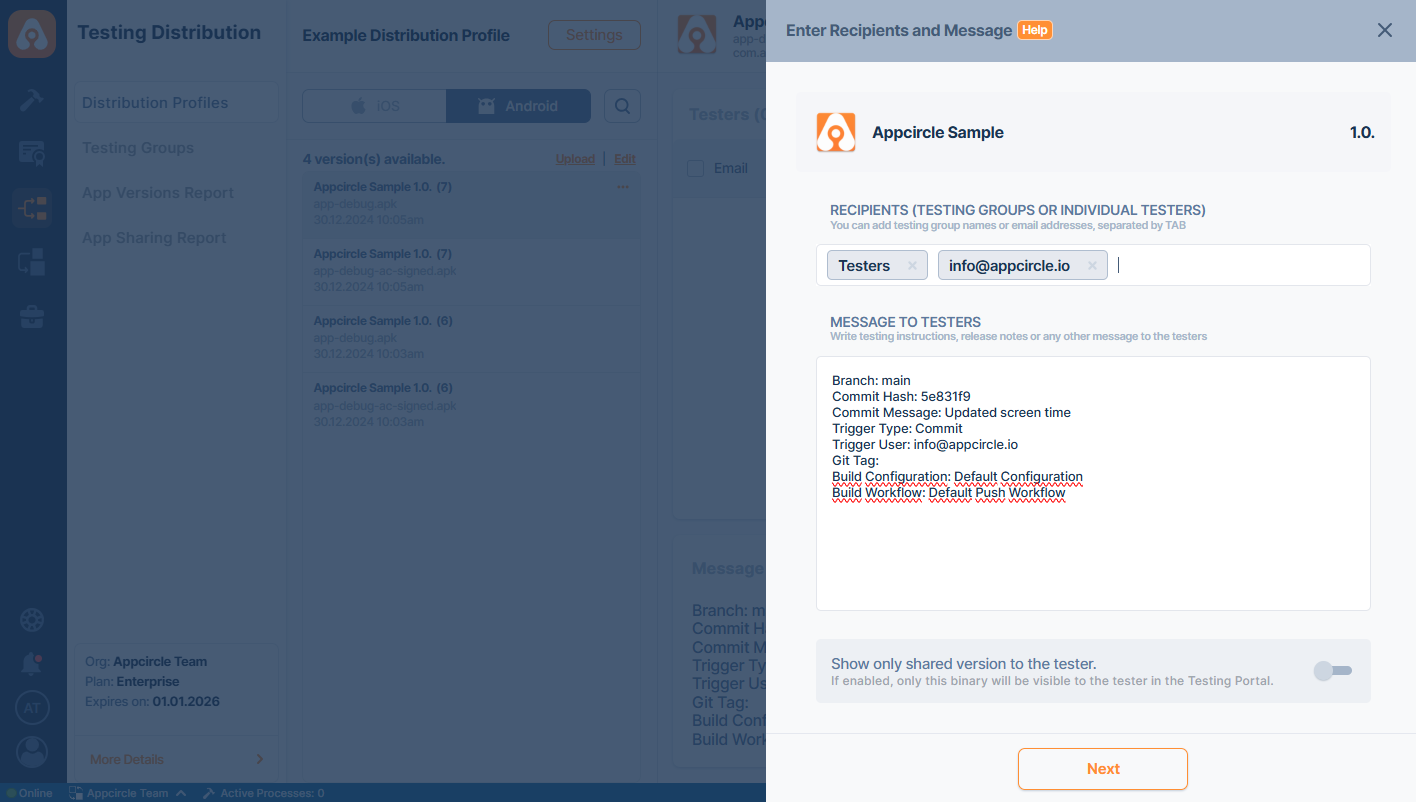
You can automate this message using Release Notes Component. You can enrich the contents of your release notes with environment variables or Ruby snippets. The following default template will print the branch name, commit hash and commit message.
Branch: $AC_GIT_BRANCH
Commit Hash: <%= ENV['AC_GIT_COMMIT'][0..6] %>
Commit Message: $AC_COMMIT_MESSAGE
If you are using the self-hosted version of Appcircle, you can configure it to use your own business domain for distribution emails instead of the default noreply@appcircle.io address. For details on how to configure SMTP settings in a self-hosted installation see Email Integration.
The Distribution Profile name will be displayed as the sender name in the email address that testers will receive.
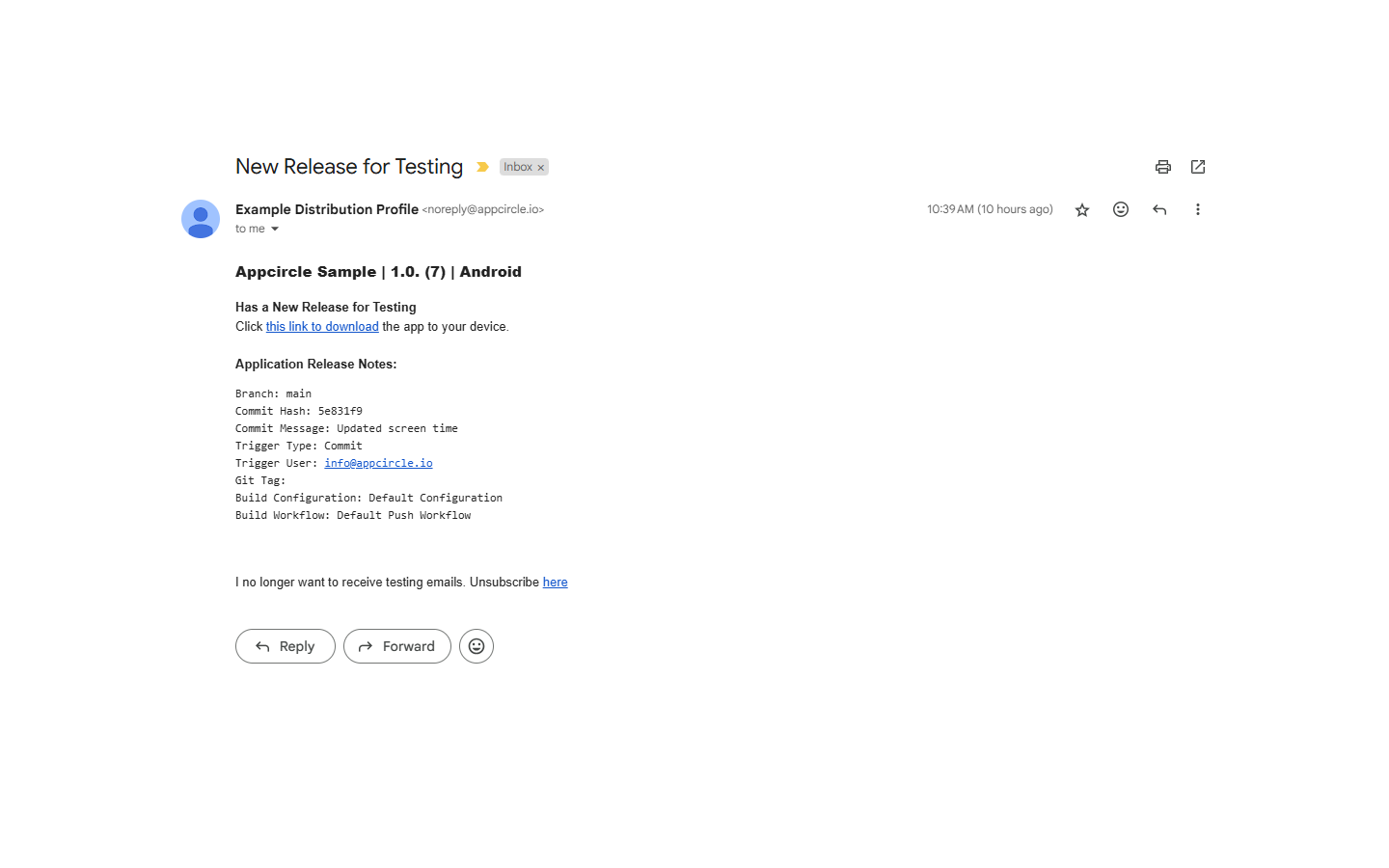
After sharing your app versions with testers, the most recent sharing time will be displayed on your testing distribution profile card.
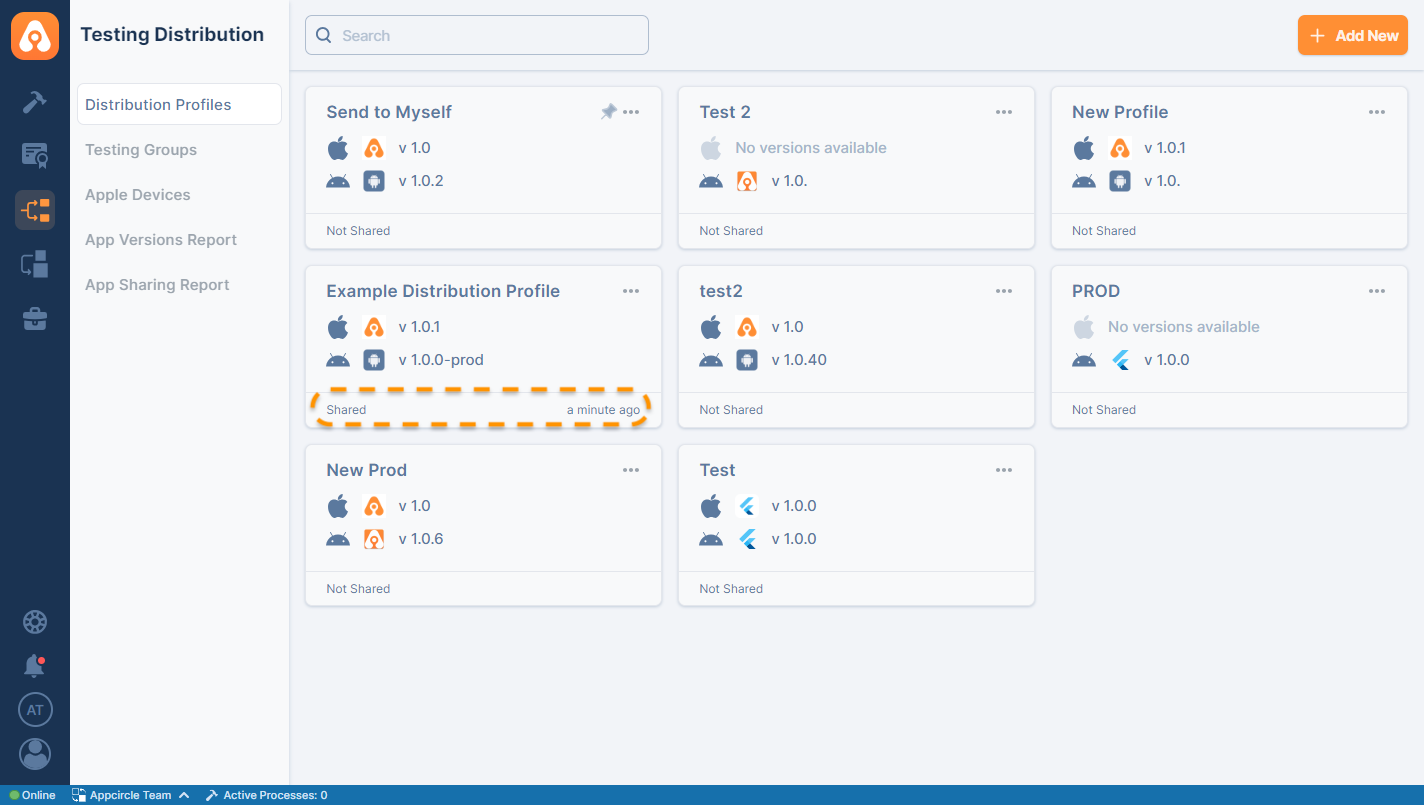
Tracking your distribution
After sending your application to testing groups, you can track the actions of testers:
- Pending - Means your tester didn't click on the link they received yet.
- Clicked - Means your tester clicked on the link they received but has not logged in to the system yet (only for authenticated distributions).
- Login, No Download - Means your tester has logged in (for authenticated distributions) and at the download screen but has not downloaded the binary file yet.
- Downloaded - Means your tester clicked and downloaded the binary file.
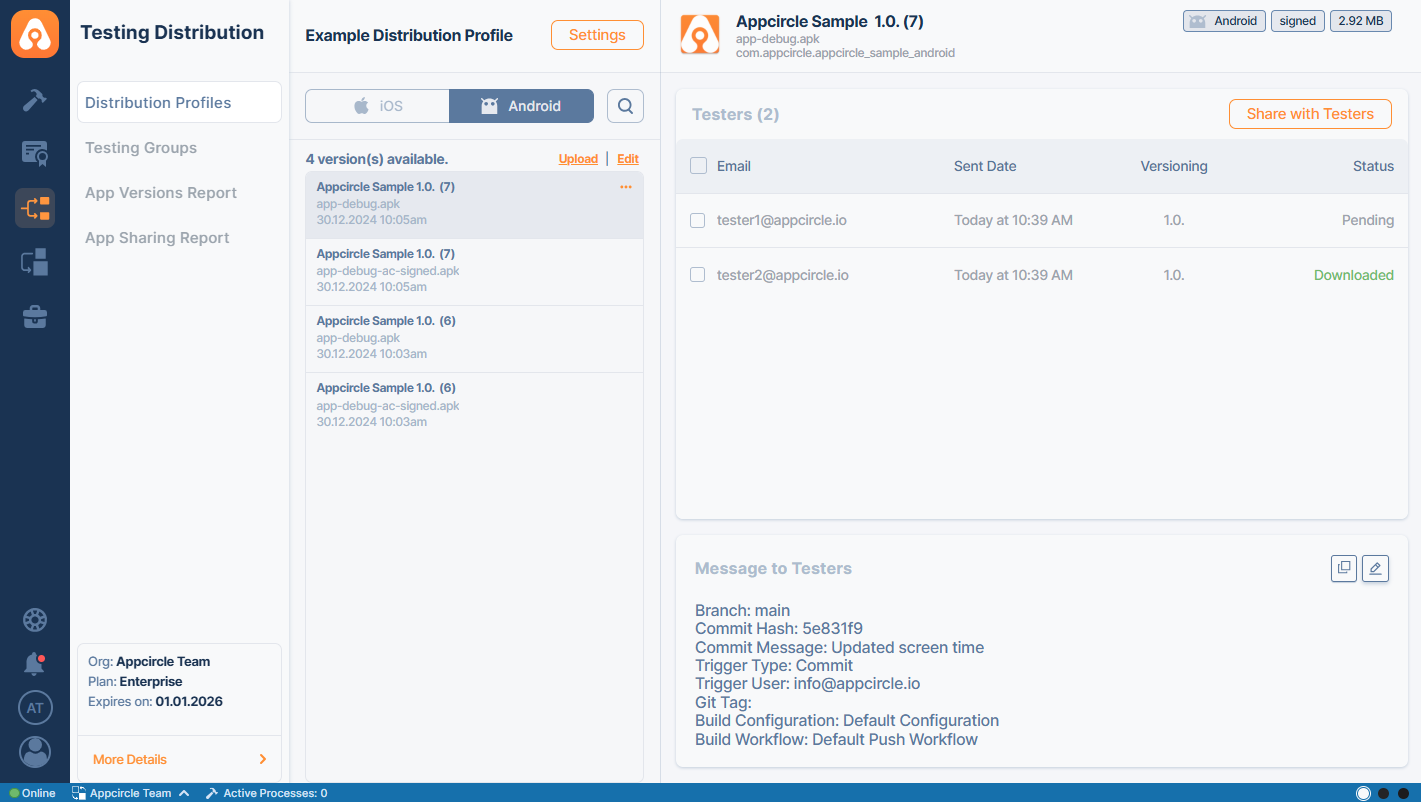
Binary Actions
Binary Information
- Select the binary.
You can select the files from the list.
- Click the ... button and select Binary Information.
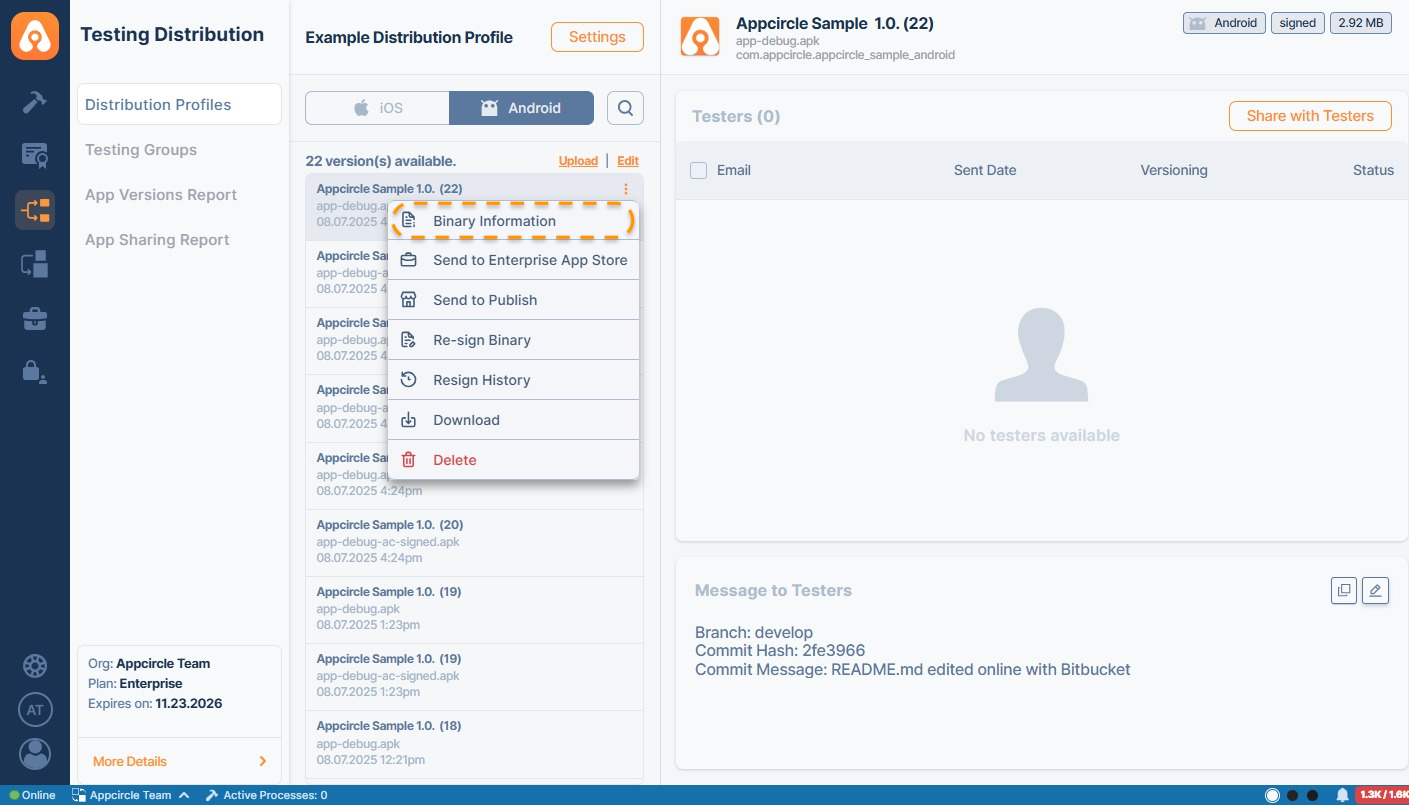
- This window provides information about your binary, including the provisioning profile type, certificate name, and build details, such as the branch and logs.
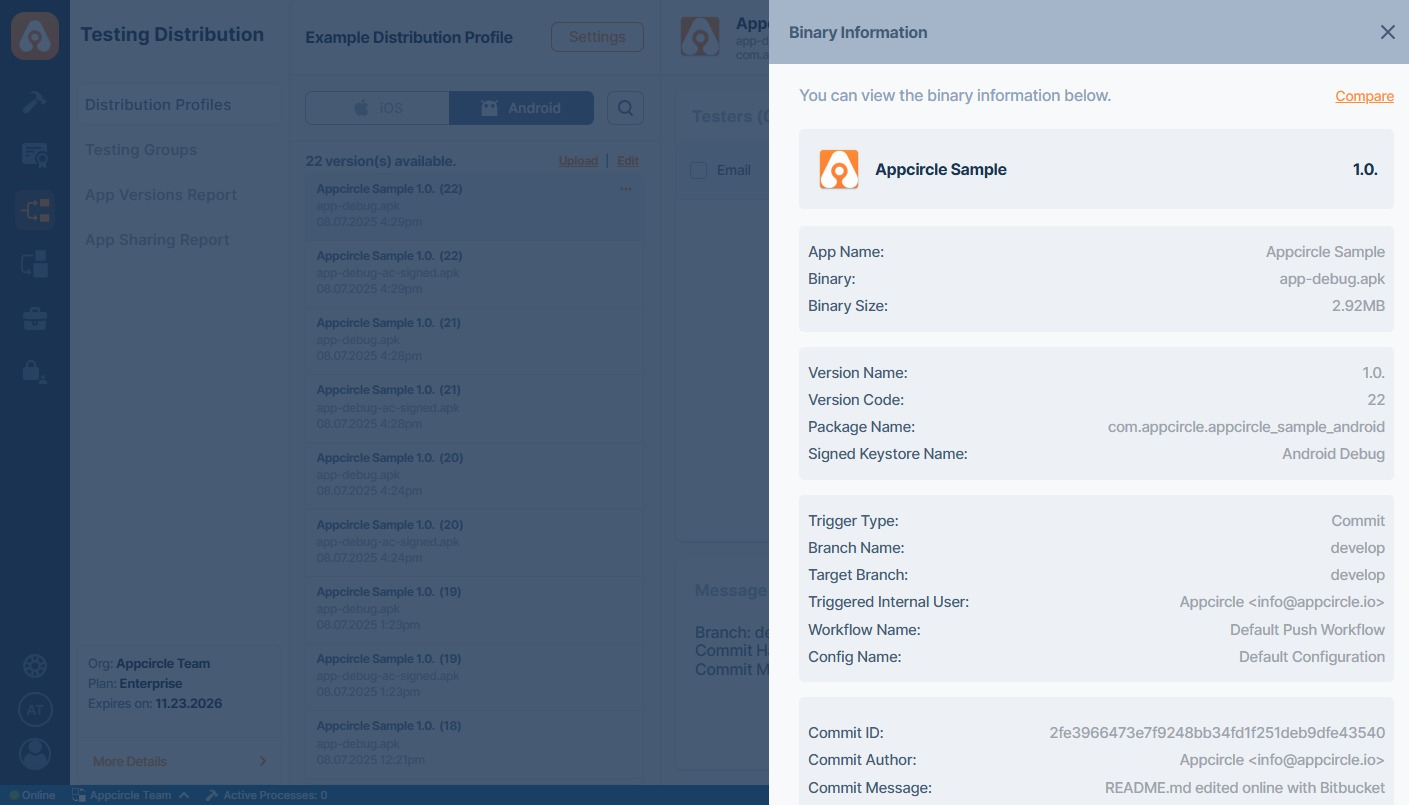
Build Metadata Details
The following metadata is displayed in the Binary Information section of a Testing Distribution Profile only when the binary is generated via the Build Module, either through automatic or manual triggers, and subsequently distributed using Auto Distribution to the Testing Distribution module.
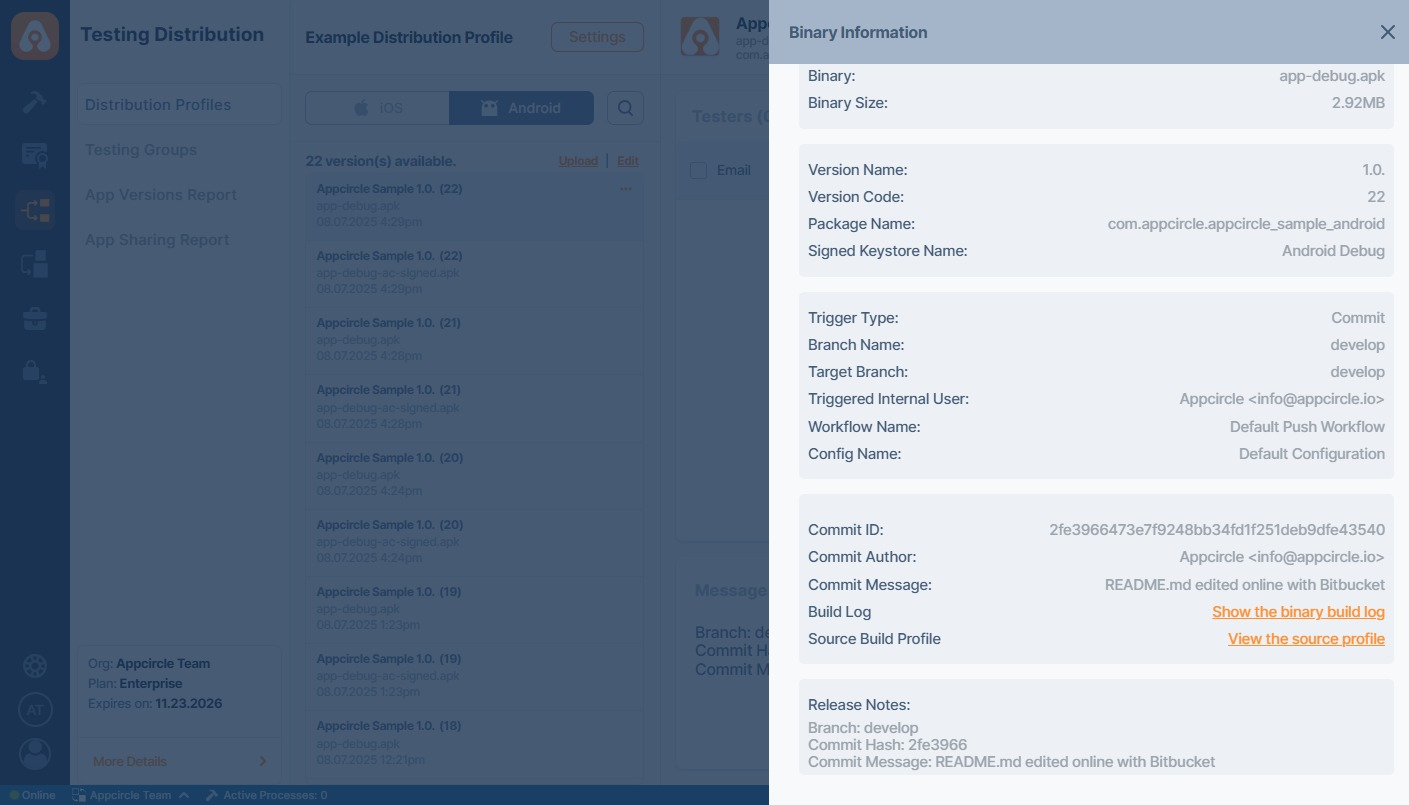
- Trigger Type: Indicates what initiated the build. Possible values include:
- Pull Request: The build was triggered by the creation or update of a pull request.
- User: A build was manually triggered by a user.
- Commit: A new commit triggered the build automatically.
- Tag: The build was initiated when a new Git tag was pushed to the repository.
- Branch Name: The source branch used during the build process.
- Target Branch: Typically used in pull request or merge-based triggers, this is the destination branch for the pull request or merge target.
- Git Tag: If the trigger type is Tag, this field shows the tag that initiated the build.
- Triggered Internal User: Displays the email address of the internal user who triggered the build or the user responsible for the action.
- Workflow Name: The name of the workflow profile name executed during the build process (e.g., Default Push Workflow).
- Config Name: Indicates the configuration profile name used within the selected workflow (e.g., Default Configuration).
Binary Comparison
In the top-right corner of the Binary Information screen, you can click the Compare button to compare the current binary with another of your choice. The comparison highlights differences between the two binaries using color-coded indicators for easy identification.
Binaries generated through the Appcircle Build Module include associated build details. However, if the compared binary was manually uploaded to Appcircle, those details will not be available for comparison.
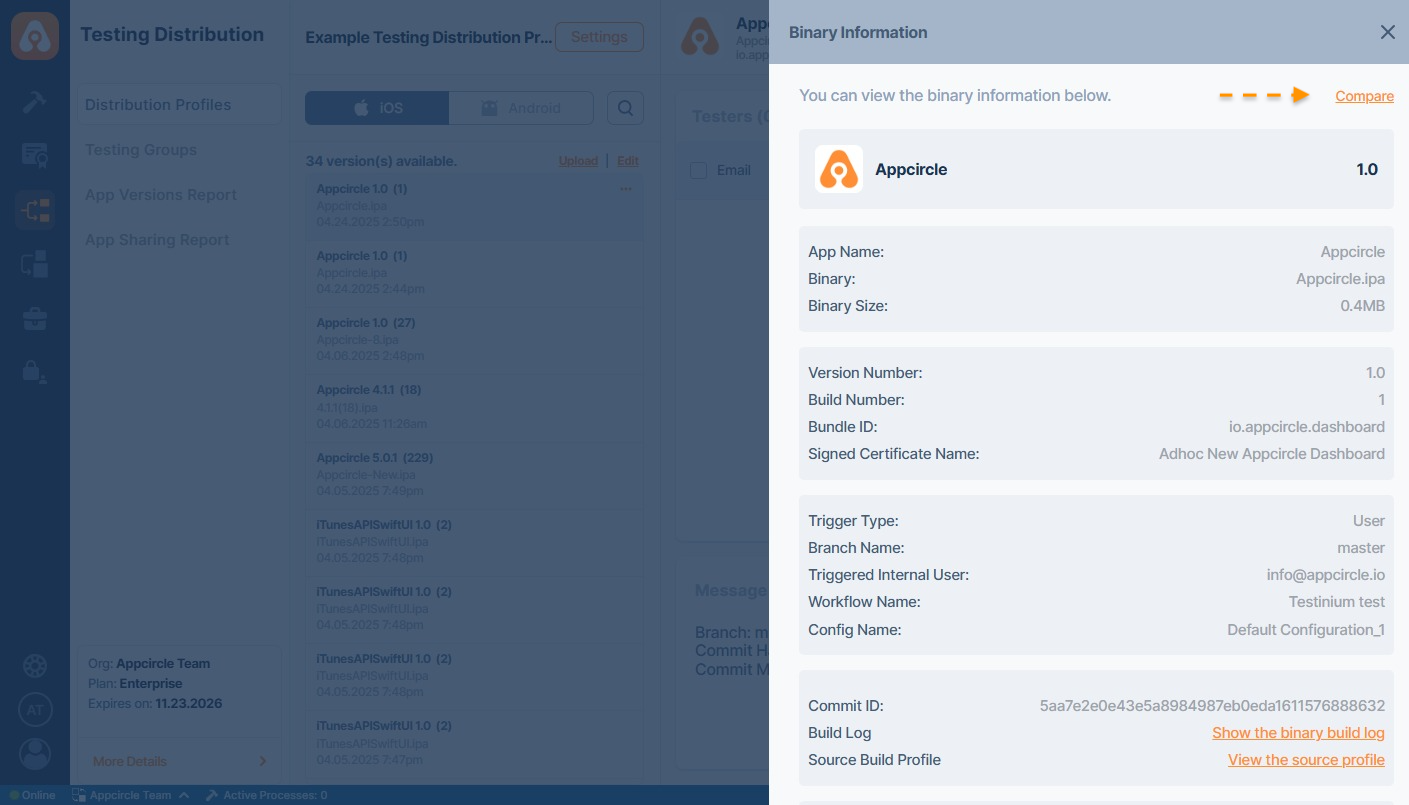
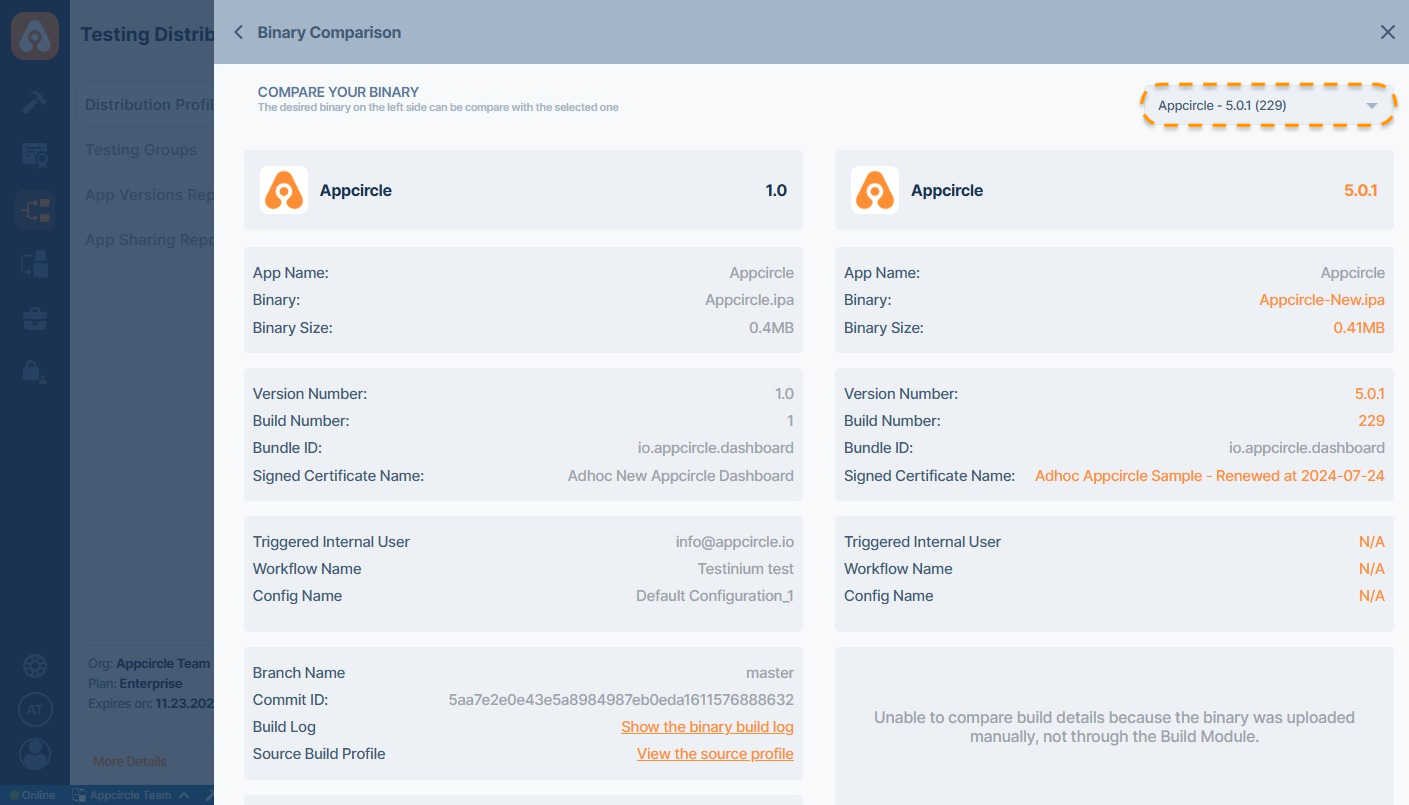
Send your application to Enterprise App Store
You can send your application from your Testing Distribution profile to an Enterprise App Store profile by following these steps:
- Click the three dots next to your application.
- Click Send to Enterprise App Store.
- Click Send.
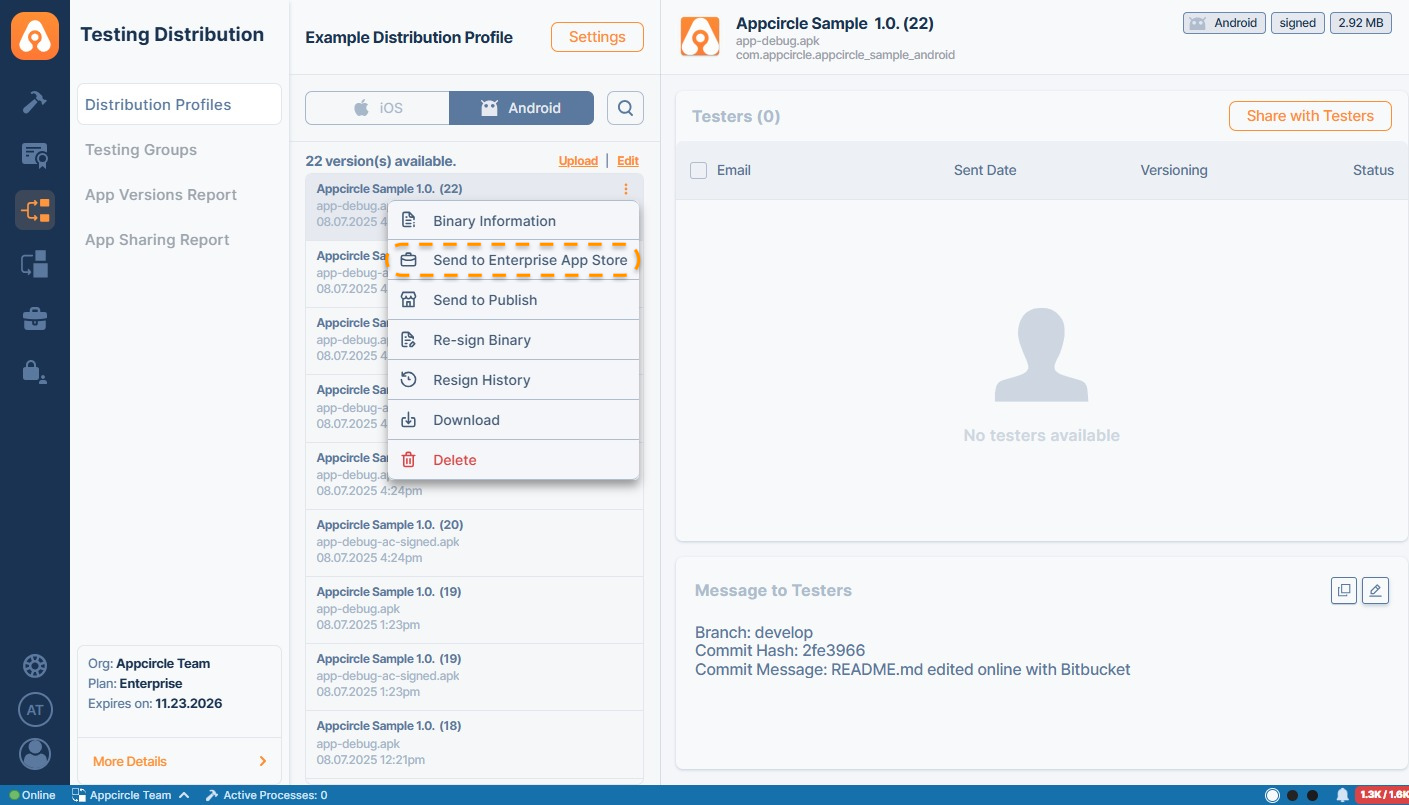
Appcircle will not ask you to pick a profile after choosing the Send to Enterprise App Store option. If the binary is unique, it will create the Enterprise App Store profile automatically. If the same app version already exists within the profiles, it will be delivered within that profile.
Send your application to Publish
You can send your application from your Testing Distribution profile to a designated Publish profile by following these steps:
- Click the three dots next to your application.
- Click Send to Publish.
- Choose your Publish profile from the list.
- Click Send.
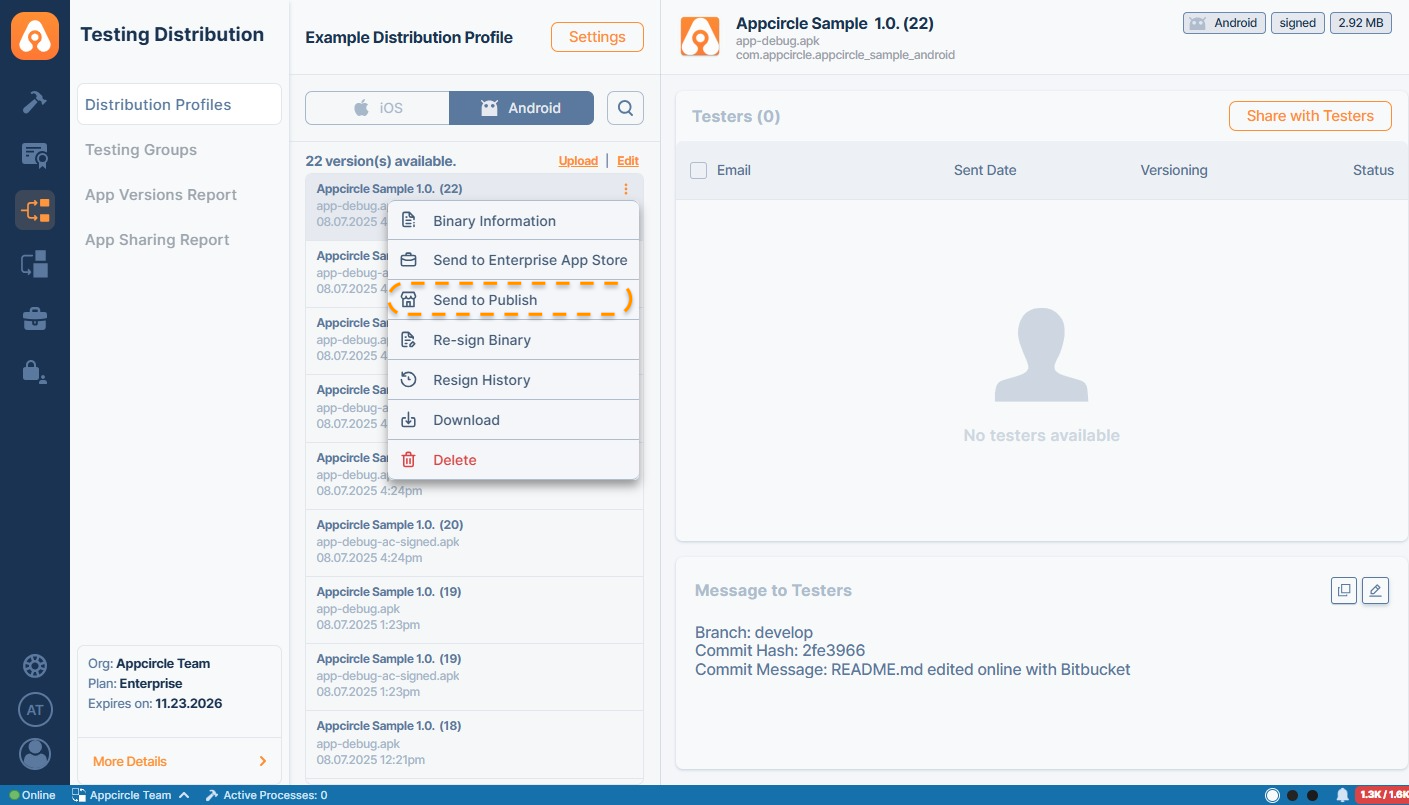
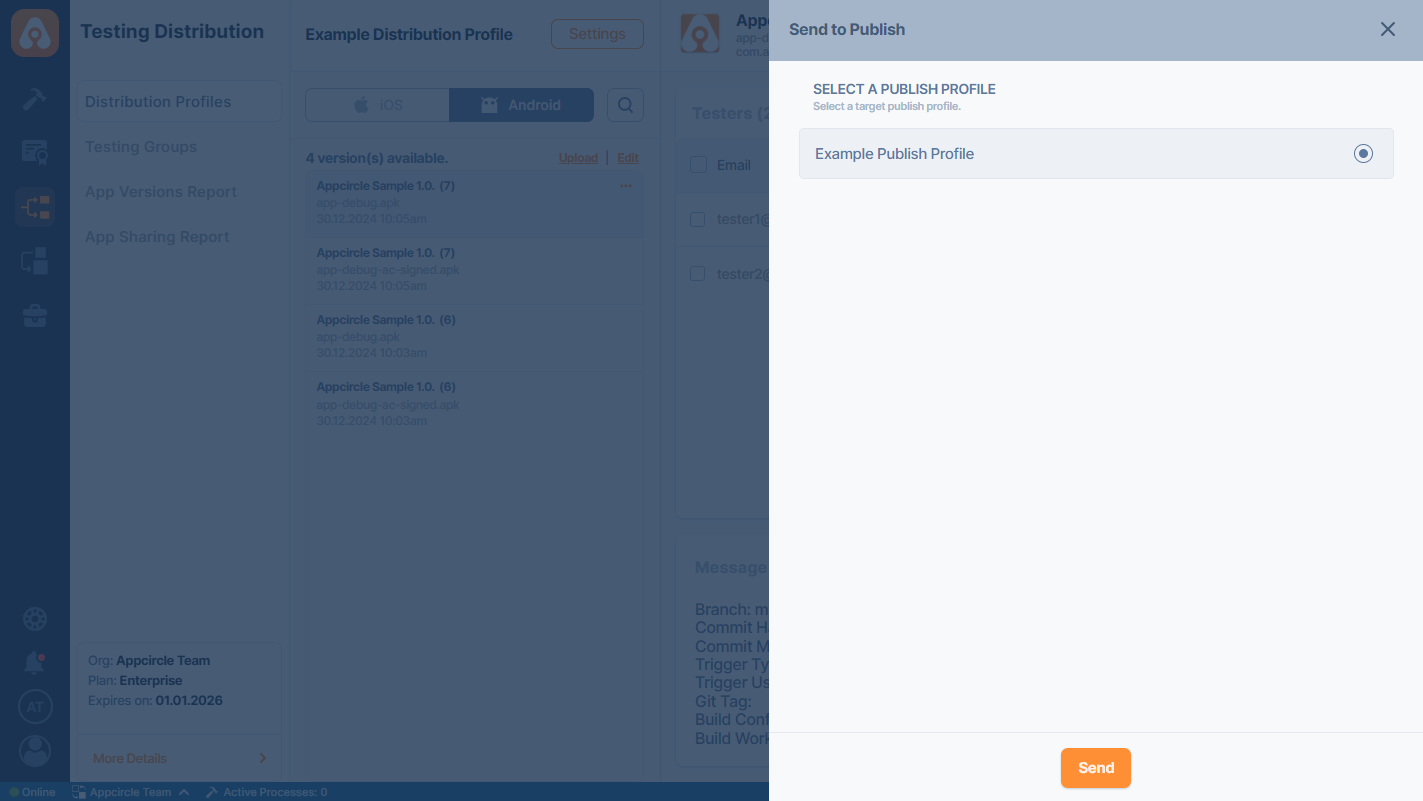
You must have already created the designated Publish profile within the Publish Module, and it should correspond to the operating system of your application (Android or iOS) listed in your Testing Distribution Profile.
Re-sign Binary
Resigning is the process of modifying an existing binary with a new signing certificate or keystore, which is required when an application needs to be published under a different developer account or when updating an existing application. It involves removing the original signature and replacing it with a new one.
For more information please visit the Re-sign Binary documentation.
Re-sign History
Re-sign History allows you to view the re-sign process logs for your app versions. For more information, please visit Re-sign History documentation.
Download Binary
The binary file in the Testing Distribution profile can be downloaded by selecting the Download button from the actions menu.
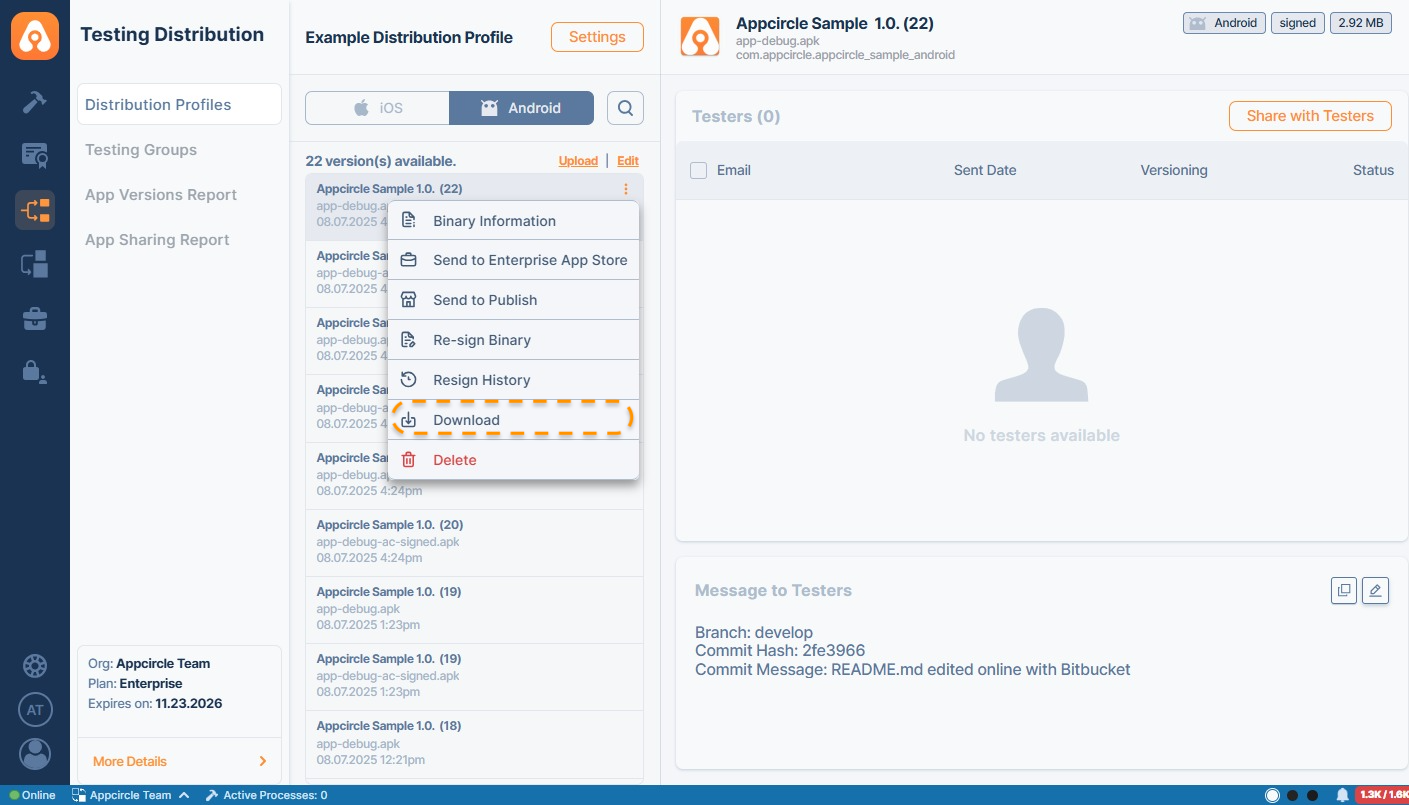
Delete Multiple Testing Distribution App Versions
If you don't want to delete an entire distribution profile but free up the past distributions, you can also remove multiple entries.
Click on the Edit Text to toggle edit mode:
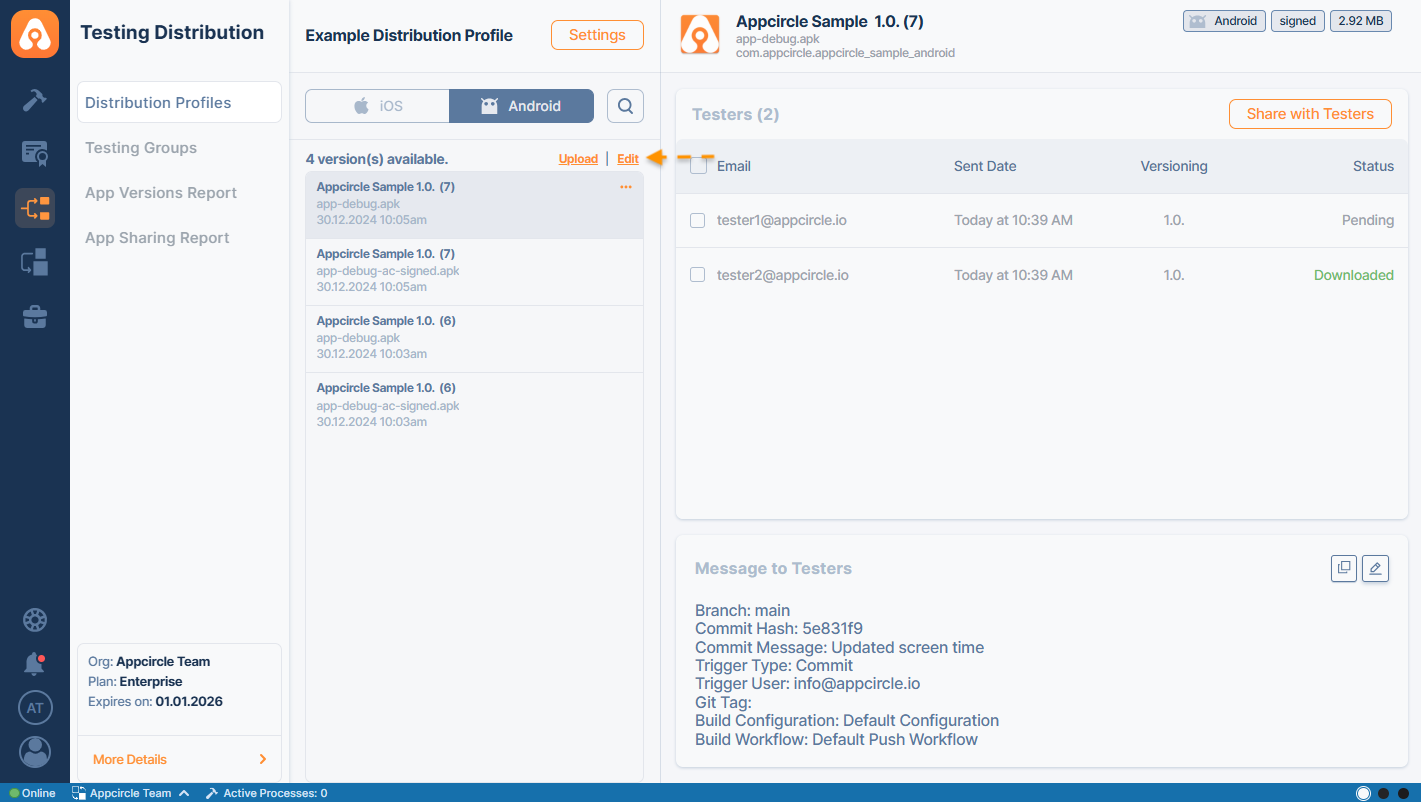
On edit mode, you will be able to select multiple entries. Select the versions you wish to delete, and click on the Delete Text on the top right of the versions:
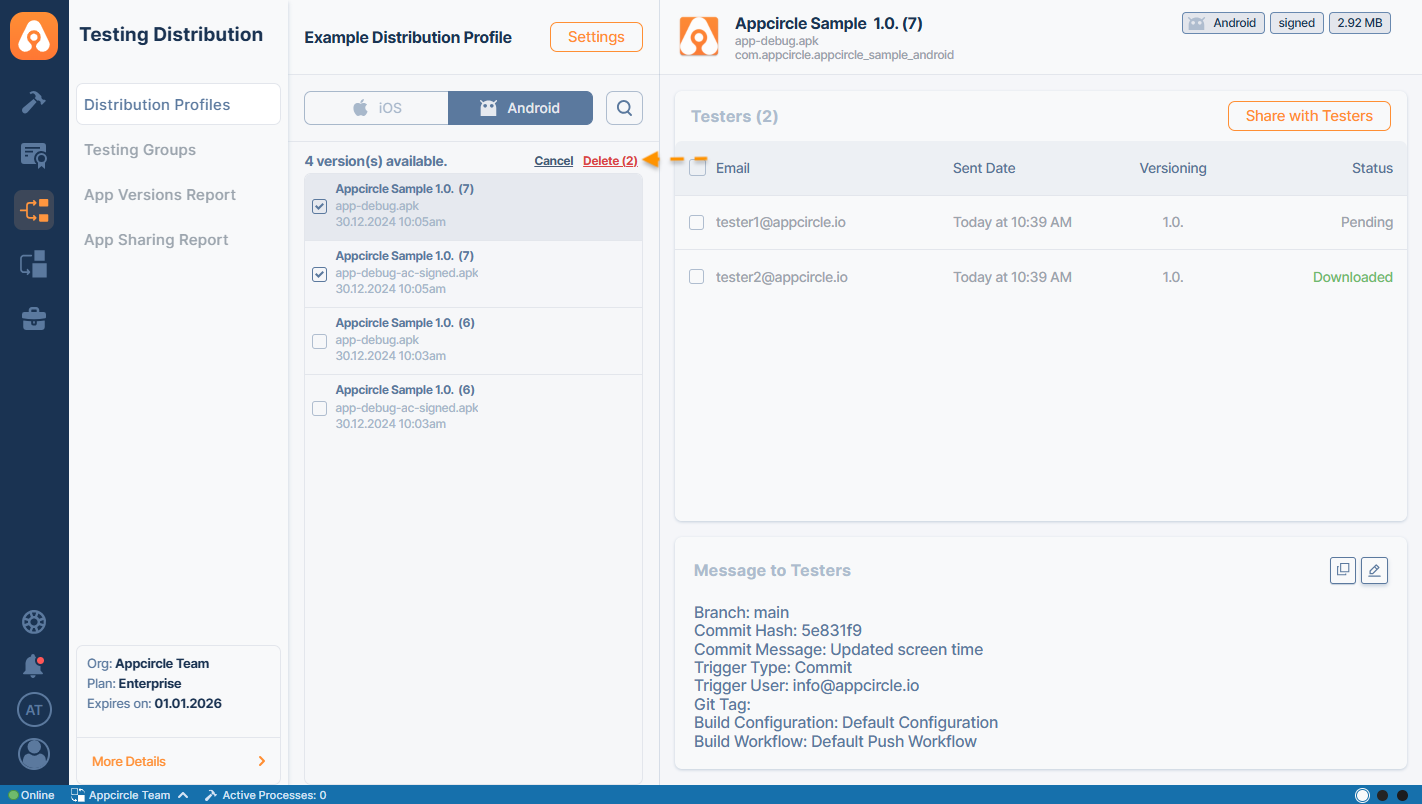
Delete a Single Distribution App Version
As an alternative method to bulk deleting versions, you can delete a single version by selecting the three-dot menu next to the app version and then clicking delete button.
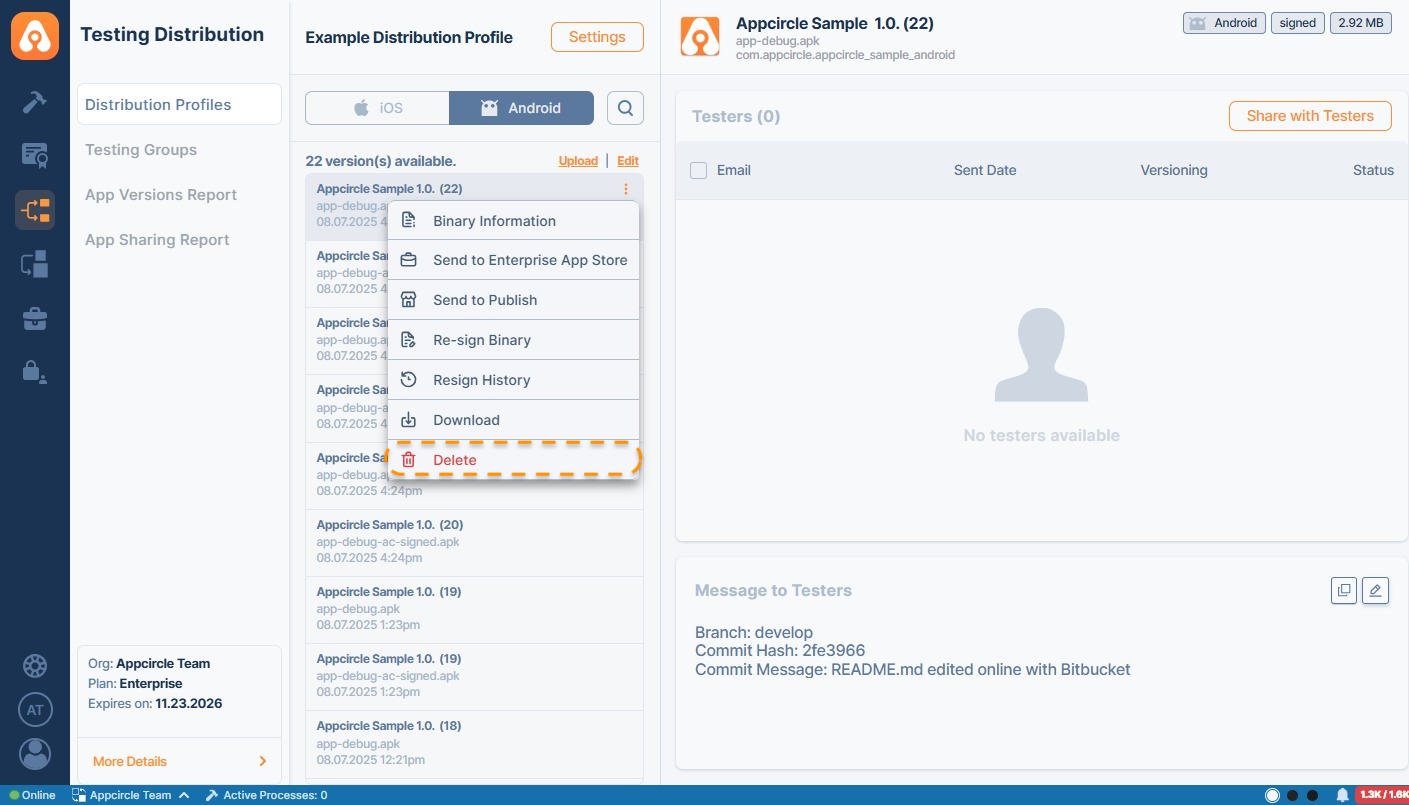
After clicking Delete , type in the version name in the prompt.
FAQ
No files or multiple files were received from autodistribute;
A successful distribution depends on a correctly signed binary. Please check if the signing configuration is correct.
You can also check the list of the generated build artifacts to confirm the output. In Android, you can also check the ac_post_process_output.json file in the build artifacts to see if the APKs are signed or not.
In Android, please also check if gradle sign is being used for the selected build variant. If gradle sign works alongside with Appcircle signing, you will receive multiple APKs.
Deleted versions still occupy storage space
The master version of any artifact deployed from the Build to the Testing Distribution is stored within the build artifacts section. Once you delete such a version from the Testing Distribution, only the reference is removed and the binary is still available within the build artifacts of the related build. You also need to remove the binary from the build artifacts to save storage.
Access Denied on builds
On some distributed apps, the Access Denied error can be bypassed by one of these steps:
- Launching the distribution link on a different browser and Incognito Mode
- Clearing the browser cache if the link is pasted to a browser instead of in-line browser on mail applications
- If there is an authorization configuration on Distribution, clearing the authorization temporarily
Can I set an authentication method for accessing the Testing Portal?
Yes, you can choose one of the authentication methods provided by Appcircle to authenticate your users and control their access to the store. For more information, please visit the Testing Distribution Authentication documentations.
Can I send a binary from another CI tool?
Yes, you can use Appcircle API & CLI tools within your current CI tool to directly send the binary and utilize it within the Testing Distribution. For more information, please visit the Appcircle API & CLI documentations.
What does email/month mean? How is the number calculated?
An email is calculated every time an app is shared via email from our servers. So every send email adds to email count.
Do you offer plans specific to Enterprise App Store (without CI/CD features)?
Thanks to the modular structure of Appcircle, all modules can be used independently. Accordingly, you can also request a special plan only for Testing Distribution. Please contact us for detailed information.
How can I get a binary from another organization to use in the Testing Distribution module?
Let’s assume there are two organizations: Organization A and Organization B. In Organization A, we have a build profile that generates an IPA, APK, or AAB. In Organization B, we have a testing distribution profile that we want to send the binary to.
In Organization A's build profile workflow, after the build step, we can add a Custom Script step that includes the code snippet below to transfer the binary generated in Organization A to the Testing Distribution profile in Organization B. In order to do this, we need Appcircle CLI, so this code snippet sets up the necessary information and sends binary with parameters.
#Bash script
sudo npm install -g @appcircle/cli
appcircle login personal-access-key --secret $ORG_B_PERSONAL_ACCESS_KEY
# If an IPA or AAB is required, change *.apk to *.ipa or *.aab
appcircle testing-distribution upload \
--distProfileId "$ORG_B_TEST_DIST_PROFILE_ID" \
--message "Release Notes" \
--app "$AC_OUTPUT_DIR"/*.apk
The key point here is that we need two essential parameters to make this work.
ORG_B_PERSONAL_ACCESS_KEY=> Personal Access Key from Organization B.ORG_B_TEST_DIST_PROFILE_ID=> Testing Distribution profile ID from Organization B.$AC_OUTPUT_DIR=> Automatically defined by the system. See Reserved Variables.
To generate Personal Access Key, follow this documentation
To obtain the Testing Distribution profile ID, follow the steps below:
- Log in to organization B.
- Go to Testing Distribution module.
- Select the desired Testing Distribution profile
- Copy it from the URL.
https://my.appcircle.io/distribute/detail/123456f-7d89-4545-5454-123456789abc - Then the Testing Distribution profile ID is =>
123456f-7d89-4545-5454-123456789abc
After collecting the required parameters, set the following values as Environment Variables:
ORG_B_PERSONAL_ACCESS_KEYORG_B_TEST_DIST_PROFILE_ID
Please do not use sensitive variables such as Personal API Token, Profile ID directly within the step.
We recommend using Environment Variables groups for such sensitive variables.
Keep in mind that the Environment Variable Group must be selected in the build profile configuration.